#in an era where i feel like there was a VERY short period (in western fandom at least)
Explore tagged Tumblr posts
Text
oh my god. a manga where everyones actually wearing masks???
edit: NEVERMIND jumped the gun here it was just for one scene cos they were at a nail salon 😭
edit 2: hmm actually. depending on how recently this manga was drawn it could just be reflective of how not everyone wears masks. the customers are wearing masks in the salon but outside usually not but Sometimes. they are
edit 3: I WAS RIGHT??
#in an era where i feel like there was a VERY short period (in western fandom at least)#where masks and covid were even mentioned in fic and art#before it dropped off completely and all fiction lived in a fantasy universe without covid...#BRO I GOT TRICKED#hmm iirc wearing a mask in japan isnt required outside anymore. so that would track#but also maybe the artist just didnt want to draw masks all the time LMAO#ok ill be honest at this point i think i just misread the situation 😭 man it would be interesting for someone to like.#draw masks all the time..... the elusive artist that likes to draw masks more than faces#i should practice drawing people with masks...#MY HEART CANT TAKE THIS ANYMORE LMAO#ok now im Really sure its just a case of wanting to show the main characters faces and not wanting to draw masks all the time#two characters have met outside for the first time and theyre both wearing masks#ok theres another bit where a character says 'good thing the flights are running again'#which i must assume is a reference to international travel being restricted at the beginning of covid#so wow.... i was right..................#idk when this was released but it must have been drawn closer to the beginning of the pandemic#the manga is internet love by urino kiko btw#hmmm it says released 2023.. thats the tankobon tho idk if it was serialised and when that happened#ok yeah serialised from late 2022... thats quite far into the pandemic actually. interesting
18 notes
·
View notes
Text
The first fanbook tells us that lately, Mitsuri is hooked on "youshoku" (Western food) like pork cutlet and omelette rice, so her expenditure on food is pretty extreme.
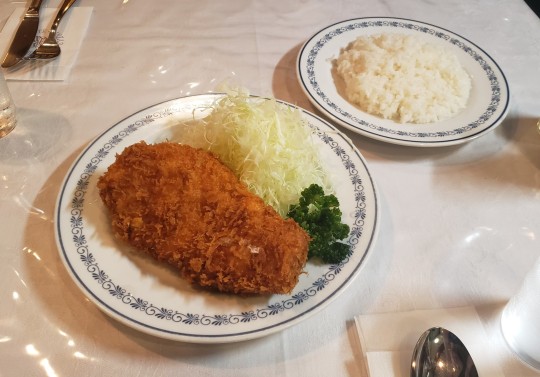
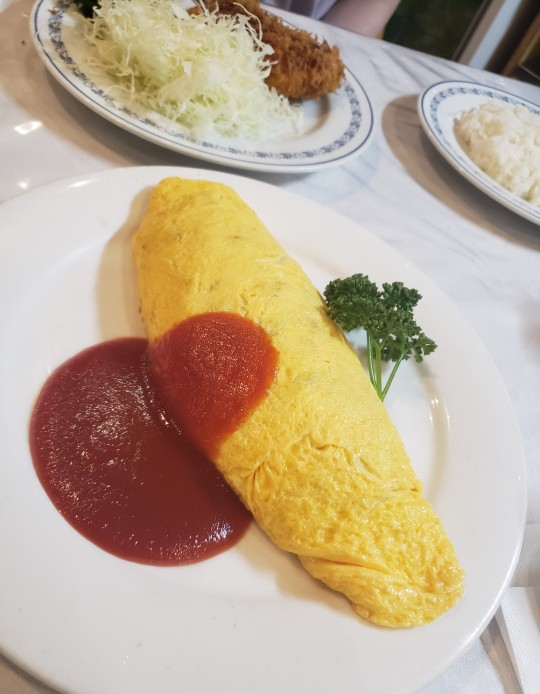
Nowadays, these Japanese-style "Western foods" are pretty ubiquitous but not actually things you run into much in "the West." The ingredients and recipes have changed here and there with how long they've been around, so a nerd buddy who knows Tokyo better than I do (and who is a Mitsuri fan) insisted I try out what these things would have tasted like in Taisho. That's why she took me to Rengatei, where some of Mitsuri's favorite dishes were born.

I'm going to let this food blog do the talking about the restaurant itself and how it has the credit for creating many well-known dishes, including pork cutlet and omelette rice. It's an interesting, short read.
We'll focus most on what Rengatei might mean for Mitsuri, and on that note, I'll call your attention to the fact that this food blog article first mentions looking for a similar restaurant with a long history in the Azabu Juban area. Mitsuri is from a spot that was known as the Iikura neighborhood of the Azabu area in the Taisho period, and what is now known as the Azabudai area. Back in the Taisho period, this was a glitzy shopping and entertainment area where Mitsuri would have had many options for popular Western style restaurants. Even today, Azabudai feels like an area meant for people who make far more money than I do.
So, if she was spoiled for choice closer to where she lived back then, would she have bothered going over to Ginza, another glitzy shopping area of Tokyo, to visit Rengatei? The restaurant opened in 1895, a year or so before she was born, so it would have been well established, but not exactly new. To that I say, let's assume she'd have had plenty of opportunities to go to Ginza. It's perfectly reasonable to assume she might have visited the restaurant that developed some of her favorite dishes. Even today, Rengatei plays up the retro atmosphere with the table setting and wait staff uniforms.
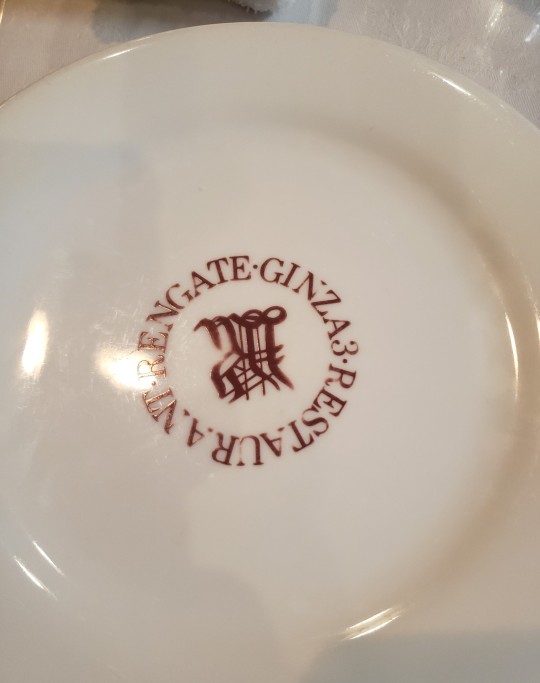
Thing is, despite the retro feeling of modern-day Rengatei, this building was constructed in the 1960s. Mitsuri's wouldn't have seen the place in the same way you can see it today.

The kicker is that it would have been the same Meiji era recipes.
My friend who took me along asked for my thoughts on the food afterward, and we arrived at the same conclusions about it being not amazing, but feeling a little imperfect compared to many other versions of these recipes that we've had. Like you can tell these were freshly developed and on the homestyle side. I had the omuraisu (omelet rice, as it is better known today instead of the long o-mu-re-tsu-rai-su* as it used to be known), and she had the tonkatsu (pork cutlet, which is also a shorter way of saying po-o-ku-ka-tsu-re-tsu*, with "ton" for "pork").
*Both the KnY fanbook and the Rengatei menu use old, long names, though there was some linguistic variation like ka-re-ka-tsu or ka-to-re-to until the current names were settled on.
So why were these sorts of foods such a big deal? There were a lot of new foods introduced to the Japanese diet over the course of the Meiji period, especially meat, since Japan was very influenced by Buddhism and not widely in the habit of eating it (but you can always find exceptions, and different strains of Japanese Buddhism vary in how much they condemn certain lifestyle choices). Many new meat dishes, like curry and sukiyaki (or rather, gyunabe as Rengoku knew it in his bentou), were fancy and expensive and novel in the Meiji period. Perhaps more surprisingly, eggs were also a luxury item (though they have a complex history in the Japanese diet).
Granted, by the time the Taisho period rolls around, a lot of high society in Tokyo has already had some time to get used to these new menu items being a thing, and how much they were adopted into people's lifestyles varied as much as how much they adopted Western attire and houses. On that note, it is very interesting how in the flashback to Mitsuri's family life, they live in a very Japanese-style home and visit Japanese-style establishments and eat Japanese-style sweets, but by the time we join Mitsuri for Hashira training, there are Western elements to her home (though it is not clear if she lives with family or not), and she eats Western style sweets (beekeeping has a long history, and Western methods of beekeeping were introduced in Meiji long before Mitsuri was born). We can see how quickly what was normal for Mitsuri changed over the course of her life, so it's possible she really hadn't been in a habit of eating Western food until closer to when she joined the Corp. While I'm sure Rengoku was happy to eat anything, his home and tastes still seem to lean distinctly non-Western in comparison.
Anyway, so how was the food at Rengatei? Back to that topic!
I usually associate restaurant omuraisu with being impeccably fluffy, and with a variety of sauces and rices seasonings to choose from, even if ketchup is traditional. However, this omelet had a distinctly flatter, more inconsistent texture than you usually get with standard restaurant omuraisu. It's closer to just the usual flat, bumpy, but at least smoothly beaten omelette you'd be more likely to accomplish at home. Even the ketchup had a bit of a freshly-blended quality to it, but I can't exactly say I'm ketchup connoisseur. For all we know about Mitsuri, she might be.
The pork cutlet was, as you get into it yourself instead of having somewhat pre-cut strips like at many tonkatsu establishments, very clearly a hunk of meat. My usual image of tonkatsu is a evenly tenderized, evenly cooked hunk of white meat, with a stretch of fat along one side. Not so with this--the textures and darkness and lightness of the meat, as well as the amount and distribution of fat, was more typical of a cut of meat that is first and foremost meat; not a uniform product. My friend really loves tonkatsu, and says she prefers this juicy, not-quite-perfected version. Because it is a greasy dish, this is why Rengatei introduced the convention of serving it a bed of shredded cabbage to aid in digestion, which all of Japan has copied ever since.
As a brief note, most online sources say "yeah, Rengatei invented tonkatsu (but we're all probably copying the same source)." It seems there is another restaurant (Ponchitei) that claims to have invented tonkatsu before or after 1897, and for what I've poked around, the claims for Rengatei's invention aren't clear, but 1899 seems like the most likely time it entered the menu (I saw a claim for 1890, but the restaurant didn't open until 1895...).
Anyway, tl,dr; I did feel I was eating something closer to what Mitsuri would have known and loved by having eaten at Rengatei.
I also felt it went to show why her food bill was so high, because Rengatei is not cheap (like, about twice what I'd typically be willing to pay). You're paying for some ambiance and history here, as opposed to just a standard meal. Also, it is worth noting that although there is scant official information for the parent restaurant in Ginza, there is a lot more information for an off-shoot restaurant in Fukagawa that opened in 1928. That includes a short, cute English article introducing Western foods.
But hey, despite the stiff prices, I was full and satisfied after one plate of omuraisu and a couple bites of pork cutlet. Mitsuri-chan has a Hashira salary, so she can afford as many servings as she likes.
117 notes
·
View notes
Text
I tried to translate 『Kokkuri-chan』 !

[ official image source ]
★ Disclaimer: I'm an english speaking casual student of the language and my translation is in no way anything but amateur, I mainly rely on kanji dictionaries and researching individual syntax with very slight MTL assistance. I started to translate Ikigusare songs late last year for myself in order to simply gain a personal understanding of the music and thought I'd share what I have for others now that the idols are finding traction in western spaces. very open to critique!
youtube
『Kokkuri-chan¹』 English Translation [ original lyrics and singable romaji ] cw: suicide
Quickly, quickly, quickly call me out! Ride the wave of the 10 yen coin Anytime, anywhere I’ll come running and won’t leave without it
The girl on your mind, does she think of you too? The friends you’ve argued with, are they still mad at you? I’m the answer to all your worries Dear Cupid, dear Angels Anything you want
Quickly, quickly, quickly call me out! Ride the wave of the 10 yen coin Anytime, anywhere I’ll come running and won’t leave without it
A girl from another school seemed to go completely insane I think a senior from this school committed suicide long ago Don’t pay rumours like that any mind Ouija Board, table turning² Anything you want
Quickly, quickly, quickly call me out! Ride the wave of the 10 yen coin Anytime, anywhere I’ll come running and won’t leave without it
It’s so fun because I’m not scared Hyakkumonogatari³, one-man hide and seek⁴ Anything you want
¹ The title of the song and setting of the MV is a reference to the Meiji era divination game Kokkuri-san ² A type of seance popular in Europe where a group places hands on a table and feels for “rotations” interpreted as communication from spirits ³ An Edo period parlour game inspired by buddhist rites in which participants would tell ghost stories late at night and extinguish candles with each one ⁴ A form of ritual which supposedly spread in the late 2000s online, one allows a demon to inhabit a doll of their choosing for a deadly game of hide and seek (no proper source)
⫘⫘⫘⫘⫘⫘⫘⫘⫘⫘
as many of the aspects of this song suggest, further reading into the subjects and rituals mentioned is highly recommended! a lot of nuance is lost in a short description and it makes for some interesting reading
support Ikigusare and their producer Namaichirou on their official channels! I own nothing but my rough translation
Website | Youtube | NicoNico | Twitter/X | Bandcamp | Shop
15 notes
·
View notes
Note
I was never into the American Doll toys cus they weren't popular in my country, but I've always had the feeling that the XX century dolls all look like they are wearing adult's outfits. And tbh I don't think it's that bad cus some of the most iconic dresses of their respective eras weren't standard styles for children. I saw someone commenting that the styles on the 90's doll look like tv characters, and I think that's accurate for dolls from other decades as well, maybe it just irks us millenials cus that's an era we were closer to living so it doesn't feel natural.
It depends on the character, as far as I can tell! Going down the decades:
Samantha definitely looks like a little girl from 1904 (see: the dropped waists and short skirts on her dresses- adult ladies in that era wore gowns at their natural waists, with long skirts, and their hair pinned up).
Ditto Rebecca. Similar age rules to Samantha's era, all well-followed. No notes there.
Claudie...was made recently and therefore her collection is peak Mattel-tastic hot nonsense, painful as that is given how amazing her story could have been. Her Meet outfit isn't too bad? Like it's believable for a 1920s girl? But everything else looks awful, from a quick Google search. Not even Adult 1920s Fashion; just bad stereotypes.
Kit seems pretty on-brand for 1930s little girls' clothing, though we're getting further from my eras of expertise. The original collection, not the BeForever BS.
Molly is, again, getting way out of my wheelhouse, but she's definitely not wearing 1940s adult fashions. It's interesting to see the same era done with Nanea considerably later in the company's timeline, because it seems much more like their later "distilled" approach to the historical characters. Less researched, less detailed, less of the period and more Generic Vintage. Also, it's the 1940s and she has NO casual dresses? Really? I get that she lives in a tropical climate, but, again. 1940s. Little girls generally wore skirts most of the time, in any place where western fashion predominated.
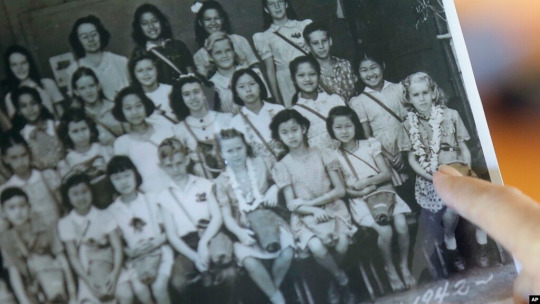
(Class photo, Thomas Jefferson Elementary School, Waikiki. 1942.)
Maryellen is very...Intensely 1950s, but based on what I've seen, she's not Overly Mature in her attire per se. I feel like they're leaning too hard on the big fluffy skirts- didn't girls often wear a slimmer silhouette for school, out of practicality? -but it's not too old for her. I don't think. and of course, this is well post-Mattel takeover, as with Claudie's collection
I feel like they're trying really hard to differentiate Melody from Maryellen, but based on photos of my mother as a kid in the early 1960s, there was a lot more bleed-over between the two decades than people realize? this is another Mattel Made It Costume-y one for me, I think. it's not too mature exactly, but it's. Off, somehow
I kind of see Julie as the beginnng of the end, in terms of research quality in the company's history. It's not WRONG, but yeah, it's only one specific aspect of the era's clothing and it's more something popularized by adults. Kids did wear the hippie look in the 1970s, but it's definitely not what you think of when you consider a child's play-clothes or school-clothes back then.
Courtney is just. Okay, while she was considerably younger, my sister was an '80s kid, and she did not dress like Madonna or a Jazzercise dancer 24/7. Serious question- is AG allergic to jeans on historical character dolls from eras wherein jeans existed?
And now we have. Clueless and The Disney Channel Exploded, coming soon to an overpriced mall store near you!
This has been an unnecessarily long walkthrough of AG thoughts with Marzi! Thanks for giving me an excuse, and I'm so sorry.
58 notes
·
View notes
Text
Writeblr (re)intro !
Hi, hi! I've had a writeblr before, but left after remaking my entire Tumblr account. Got a bit busy, but missed the community so much that I wanted back in <3
-About me-
Korka or Corky - whichever you prefer
adult
undergrad majoring in two foreign languages and their respective literature :>
I've been writing for about as long as I've known of myself, but only started taking it seriously in the last 5-6 years, and only in the past year or two did I really start figuring out what I want to write, so my style is still unpolished and I still consider myself in my "finding myself" era
major procrastinator and experiencer of what I think is executive dysfunction; I will try my bestest to be active on here, but I might take a week or seven to read a single excerpt, though not for lack of interest or trying!! Nevertheless, please tag me in your works so I won't lose them in the dash :3
-What I write-
prose, short story lover, but I have about three WIPs that would be about the length of a novel(la) (that planning stage sure is planning)
literary movements I draw inspiration from the most are the romantic period (especially gothic) and symbolist movement, as well as the spirit of avant-garde's experimentation and pushing boundaries
my biggest role model is Charles Baudelaire :>
genres I like to stick to: fantasy, horror, horror/dark fantasy, recently tried experimenting with social satire, but we'll see how that goes
I feel most comfortable in fantasy and historical, but I love writing horror the most
I love worldbuilding and writing body horror/gore the most, but describing body language and appearance is something I desperately need to work on
I'm a planner and a perfectionist, so it might take some time for me to intro my WIPs properly, but I'm more than happy to talk about my OCs in the meantime :>
I have four WIPs in varying stages of planning, all still practically nameless:
a historical (time-travel) coming-of-age WIP meant to be about the length of a novel-novella (skeletal stage, planning out characters and main plot points)
a fantasy political intrigue WIP of a similar length (planning stage, details need to be ironed out before I can work on it, but i have an outline, sort of)
(and the spin-off horror fantasy collection of short stories WIP set in the same world) (skeletal stage, planning out the characters and the storylines)
a satirical WIP on the "tiktokification" of the arts, mainly literature, and anti-intellectualism (newest, researching stage; I know nothing about this yet beyond the core message and idea, but I'm looking forward to developing it)
-What I'd love to read-
genres: horror (especially dark fantasy!!), fantasy, "cheesy" romances, historical!!!!! I'm not too picky on genres, but if you mix horror in it, I'll love it even more
details: ngl those hyper-specific fantasy academy settings in coming-of-age stories hit different, detailed worldbuilding is everything to me, best-friends-to-lovers? chef's kiss. enemies-to-lovers? even louder chef's kiss. Morally ambiguous characters, morally questionable protagonists, I just love when the cast is formed of imperfect characters where you can't with 100% certainty say "x is evil" or "y is good". Make me think !
I also love reading poetry, though I'm not the best at analysing it and understanding particularly deep analogies, I love poetry that deals with abstract feelings, interpersonal relationships and personal philosophies <3
-I don't know how to end this :> -
A bit more about what i love writing/reading:
I'm from a Slavic country and dislike the way Slavic characters get written in western media, so most of my OCs are Slavic and I love to see a fleshed out Slavic character
I love body horror as an allegory for bodily autonomy and beauty standards. It's fun as horror, too, but as an allegory - very fun to explore
In general, I'm weak for a good symbol
And on me:
I spent most of my time in the last few years writing fanfiction, but so eager to focus on original fiction, too
I tend to write on-and-off, I'm either busy or tired, and sadly can go months without any progress :< I hope this changes as I get more settled into life
But! I've taken a recent liking to just making OCs without any particular WIP attached to them, so I'll probs talk about them if nothing else :)
I just missed the community of a writeblr a lot, so I'm hoping to make friends on here ! ^_^
#um i hope this works as an intro#i think i got everything lmao#writeblr#writeblr intro#i kept putting off finishing this (see: procrastinator) but when i opened my drafts all i had to add was the final two paragraphs
19 notes
·
View notes
Text

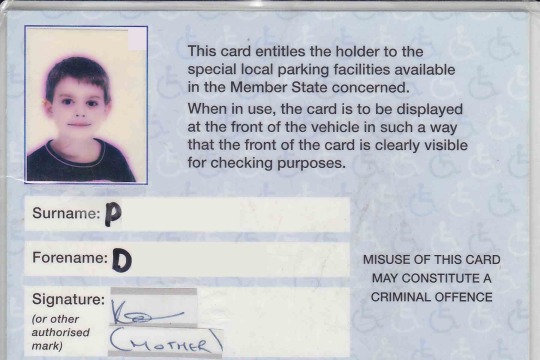
I’ve been meaning to do one of these for a while so here goes…
whenever I say I’m an "elder" of disability on here or anywhere else, even IRL, the above is just one of the many things I use to justify it
the full collective of these form parts of a whole which I am deciding to show on my blog
gonna call it "The Other Kind of Rainbow Pride" 'cos of the class I was in during Primary school. One of the first dedicated autism classes in the world
NOTE that I’ve whited bits of it off so that no-one else may attempt to use this to nefarious ends
—————
I was born on the 13th of July 1992 – subsequently named "Dominic John Powers" – in England, specifically Epsom which is just outside of the south-western part of London, although I would grow up just inside of it. My bod was routinely Assigned Male At Birth, which is something that’ll bear much significance later so I’ll only bring it up when necessary
to slice a long bread short, I got diagnosed with Aspergers and ADHD, along with a couple other comorbidities, when I was about 4, which meant being put through a very emotionally brutal system in the mid 90s. Anyone who knows about English hospitals and the surrounding 'health' industry in that era will understand why that’s awful. We really were being experimented on
needless to say this left its lasting mark on me and the role I was to have now and especially later, something which I’m still working to surpass. Namely that of not quite an invalid, but neither a normality. In fact I was registered disabled by the state shortly after the DXing process, which led to a series of provisions getting issued by our council one of those being the "Blue Badge" I’ve posted above
amongst my family at the time only grandad had one, having suffered a severe and debilitating stroke about a decade prior. Indeed, much was the stigma of being a young child exiting a car parked in any disabled section and receiving abuse from the public most of whom had no idea about the implications of NeuroDiversity at the time, let alone the chronicity and complexity we faced
this continued into events which should have been fun such as at theme parks where my aidies (ADHD) made queuing impossible for me and would have caused danger on the rides had it not been compensated for. Other families accused us of "jumping the line", unaware of the challenges we dealt with in a society and culture where more than 99% of children just didn’t have the issues I and other aidies (people with ADHD) did and, in some of our cases, still do
that badge was due for renewal in 2003 which, given they expired every 3 years, means it got issued in 2000. It was my 2nd, the first being 1997. I was 5. Barely 1800 days old
and that is one of the many reasons I call myself an elder and act as such. As someone who has risen above a LOT over a long period of time, and endured much when not a lot of people were, I have in most cases almost unique experience and thus insight into many of the issues us mentally disabled people face and how it extends unto our physical existences
—————
to close then, I’ll say this…
no one is inherently more disabled than anyone else. However, some people are merely un-abled, meaning they have no advantage over anyone else. Imagine what it feels like and does to someone being actively disadvantaged. That will objectively leave you with more disability than another…
#Disability Tuesday#elder posts#The Other Kind of Rainbow Pride#TOKoRP#ADHD#aidies aidie aidy#AS (Asperger Syndrome)#aspies aspie aspy#Walking autism history is me and don'chall fuhgeddit
2 notes
·
View notes
Text
mid sem objects 4
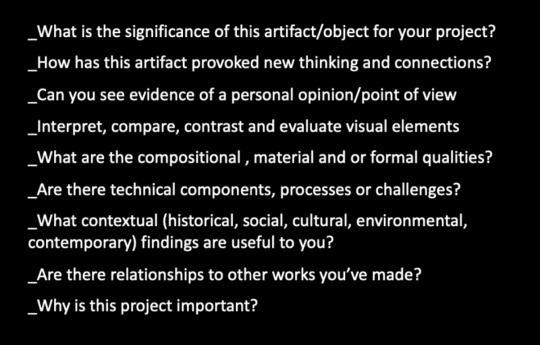
Choker Necklace from great-grandmother:
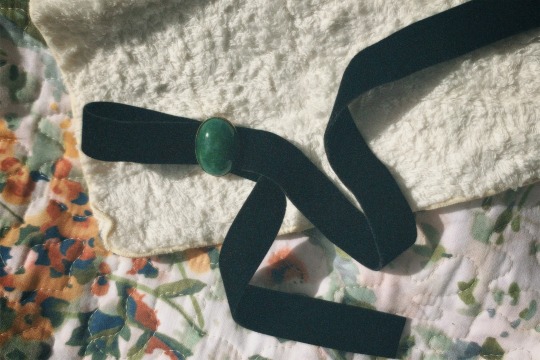
My great-grandmother was born in the 15th year of the Taisho period in Japan, the very last year of that period (1926) before it changed to Showa. She unfortunately passed away at the end of last year but I heard many stories about her from my grandfather(her son). I did my research paper in my first year about Taisho design and learned about how design in Japan was revolutionised. In short summary, Taisho era art and design was significant as it was when Western culture started to become widely popularised and mixed with Japanese traditional culture. This created a unique style referred to as Taisho Roman in current days to point to the characteristic balance of the merging of Western and Japanese culture where it has a retro yet modern look. Side note, it is also crazy to think that she was alive at the same time as some of the significant Japanese Bungo novelists (mentioned in Kenshi Yonezu's section)...
Earrings from grandmother:
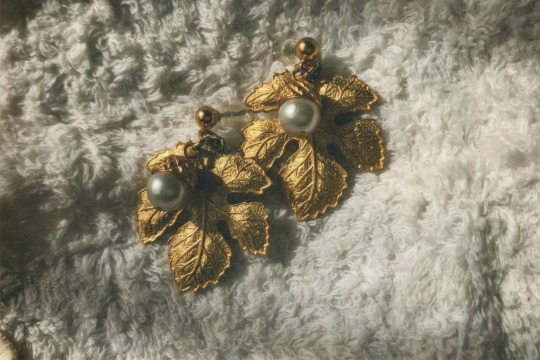
My grandmother on my father's side gave this to me when I was in Japan for year 9. At that point, I hadn't pierced my ears. This reminds me of my ancestors as I heard stories about her and her marriage with my grandfather who was a Korean man. My grandfather passed away when my father was 14. At her time marrying people from a foreign country was still not welcomed and I heard briefly that this led to a lot of difficulties. It astounds me that whilst all that trouble they still married and their three children led to more children like myself and my cousins. It also reminds me that my family is the only one that moved overseas and I always feel disconnected from my family in Japan. It makes me think of the miracle as well as the fragility of family relations. Now my ears are pierced and this is one of my favourite accessories to wear. I don't know what my grandmother felt giving this to me back then, I hope someday I get to know her a bit more.
Kenji Miyazawa bookmark:
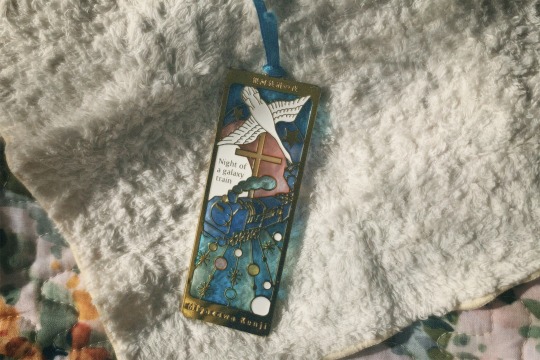
I got this when I went to the souvenir shop at Geibikei Gorge in Iwate prefecture. Geibikei Gorge is one of the locations in the 100 Landscapes Japan selection from 1927 as well as being designated the National Place of Scenic Beauty and Natural Monument since 1923. This location and Kenji Miyazawa are incredibly significant for the culture of my born prefecture in Japan. The image depicted on the bookmark is perhaps his most famous work, the Night of the Galactic Railroad. At first I was simply interested in Miyazawa because he is from the same prefecture as me, but through many other influences such as Hayao Miyazaki, Kenshi Yonezu, or Yorushika, I started taking an interest in Japanese literature. Miyazawa's works have a dreamy children's book type of atmosphere, while also being mysterious and almost creepy. His unique world in his works speaks to both children and adults. It definitely fueled my love for beautiful, nostalgic world-building and the unique atmosphere of Japanese literature.
Key of the old house in Japan:
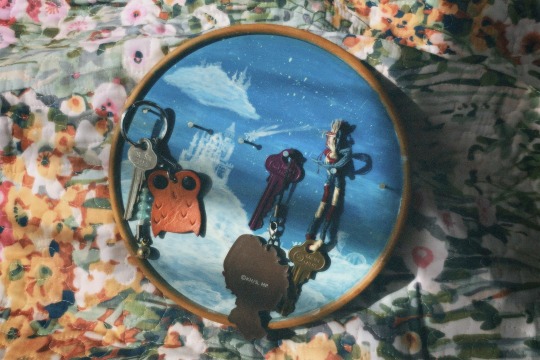
Before I moved to New Zealand in 2010 I used to live in a tiny house located above a restaurant in Japan. This key reminds me of my grandfather whom I never met. I understand this is a sensitive topic for a lot of people if I really dig into it, but ancestry and culture is a crucial part of my creativity. My grandfather on my father's side as mentioned is Korean, and he was one of the people taken to Japan through war. We were quite poor and the house that we lived in was old and broken down. My grandfather had built the place when he was younger as he worked in a factory, the restaurant was his brother's Korean food restaurant. It's sad that I can't go back to that place anymore as the restaurant has taken over. I got this key when I was in Japan in year 9 and it was perhaps one of the hardest times of my life being in a small town as a foreigner who could barely read textbooks at school, but it's also when I started learning how to learn, to work hard for myself, and do things without being told. It's also when I actually got a chance to communicate with my family members and it felt special being back in my childhood home once again.
Picturebooks?

Other than drawing one of my favourite activities as a child was reading picture books. I've had these since being in my old home in Japan, and it's clear that I was very introverted all my life. One of the first examples of creative illustration and storytelling I had was through these picture books and I think it shows through my current interests and works the impact picturebooks has on me. Some of these are Japanese, but some are translated from foreign countries. My mother is very interested in overseas culture and arts especially those from the UK area. I think her collecting these works for us to see has fed our creativity in a unique way.

The clock on the right-hand side is from my mother who had this since she was a student. It depicts Alphonse Mucha's work on the clock face. Again, my mother was really into art culture from a young age and her influences are very prominent in my upbringing. It is said that Mucha was fond of Japanese art, backed up by the point that Art Nouveau has references to the flat, curved, and decorative nature of Japanese traditional art. Likewise, Japanese art during the Meiji era was also influenced by the style of Mucha. His style had a lasting impact on Japanese manga comics as well.
0 notes
Text
race & culture in fandom
For the past decade, English language fanwriting culture post the days of LiveJournal and Strikethrough has been hugely shaped by a handful of megafandoms that exploded across AO3 and tumblr – I’m talking Supernatural, Teen Wolf, Dr Who, the MCU, Harry Potter, Star Wars, BBC Sherlock – which have all been overwhelmingly white. I don’t mean in terms of the fans themselves, although whiteness also figures prominently in said fandoms: I mean that the source materials themselves feature very few POC, and the ones who are there tended to be done dirty by the creators.
Periodically, this has led POC in fandom to point out, extremely reasonably, that even where non-white characters do get central roles in various media properties, they’re often overlooked by fandom at large, such that the popular focus stays primarily on the white characters. Sometimes this happened (it was argued) because the POC characters were secondary to begin with and as such attracted less fan devotion (although this has never stopped fandoms from picking a random white gremlin from the background cast and elevating them to the status of Fave); at other times, however, there has been a clear trend of sidelining POC leads in favour of white alternatives (as per Finn, Poe and Rose Tico being edged out in Star Wars shipping by Hux, Kylo and Rey). I mention this, not to demonize individuals whose preferred ships happen to involve white characters, but to point out the collective impact these trends can have on POC in fandom spaces: it’s not bad to ship what you ship, but that doesn’t mean there’s no utility in analysing what’s popular and why through a racial lens.
All this being so, it feels increasingly salient that fanwriting culture as exists right now developed under the influence and in the shadow of these white-dominated fandoms – specifically, the taboo against criticizing or critiquing fics for any reason. Certainly, there’s a hell of a lot of value to Don’t Like, Don’t Read as a general policy, especially when it comes to the darker, kinkier side of ficwriting, and whether the context is professional or recreational, offering someone direct, unsolicited feedback on their writing style is a dick move. But on the flipside, the anti-criticism culture in fanwriting has consistently worked against fans of colour who speak out about racist tropes, fan ignorance and hurtful portrayals of living cultures. Voicing anything negative about works created for free is seen as violating a core rule of ficwriting culture – but as that culture has been foundationally shaped by white fandoms, white characters and, overwhelmingly, white ideas about what’s allowed and what isn’t, we ought to consider that all critical contexts are not created equal.
Right now, the rise of C-drama (and K-drama, and J-drama) fandoms is seeing a surge of white creators – myself included – writing fics for fandoms in which no white people exist, and where the cultural context which informs the canon is different to western norms. Which isn’t to say that no popular fandoms focused on POC have existed before now – K-pop RPF and anime fandoms, for example, have been big for a while. But with the success of The Untamed, more western fans are investing in stories whose plots, references, characterization and settings are so fundamentally rooted in real Chinese history and living Chinese culture that it’s not really possible to write around it. And yet, inevitably, too many in fandom are trying to do just that, treating respect for Chinese culture or an attempt to understand it as optional extras – because surely, fandom shouldn’t feel like work. If you’re writing something for free, on your own time, for your own pleasure, why should anyone else get to demand that you research the subject matter first?
Because it matters, is the short answer. Because race and culture are not made-up things like lightsabers and werewolves that you can alter, mock or misunderstand without the risk of hurting or marginalizing actual real people – and because, quite frankly, we already know that fandom is capable of drawing lines in the sand where it chooses. When Brony culture first reared its head (hah), the online fandom for My Little Pony – which, like the other fandoms we’re discussing here, is overwhelmingly female – was initially welcoming. It felt like progress, that so many straight men could identify with such a feminine show; a potential sign that maybe, we were finally leaving the era of mainstream hypermasculine fandom bullshit behind, at least in this one arena. And then, in pretty much the blink of an eye, things got overwhelmingly bad. Artists drawing hardcorn porn didn’t tag their works as adult, leading to those images flooding the public search results for a children’s show. Women were edged out of their own spaces. Bronies got aggressive, posting harsh, ugly criticism of artists whose gijinka interpretations of the Mane Six as humans were deemed insufficiently fuckable.
The resulting fandom conflict was deeply unpleasant, but in the end, the verdict was laid down loud and clear: if you cannot comport yourself like a decent fucking person – if your base mode of engagement within a fandom is to coopt it from the original audience and declare it newly cool only because you’re into it now; if you do not, at the very least, attempt to understand and respect the original context so as to engage appropriately (in this case, by acknowledging that the media you’re consuming was foundational to many women who were there before you and is still consumed by minors, and tagging your goddamn porn) – then the rest of fandom will treat you like a social biohazard, and rightly so.
Here’s the thing, fellow white people: when it comes to C-drama fandoms and other non-white, non-western properties? We are the Bronies.
Not, I hasten to add, in terms of toxic fuckery – though if we don’t get our collective shit together, I’m not taking that darkest timeline off the table. What I mean is that, by virtue of the whiteminding which, both consciously and unconsciously, has shaped current fan culture, particularly in terms of ficwriting conventions, we’re collectively acting as though we’re the primary audience for narratives that weren’t actually made with us in mind, being hostile dicks to Chinese and Chinese diaspora fans when they take the time to point out what we’re getting wrong. We’re bristling because we’ve conceived of ficwriting as a place wherein No Criticism Occurs without questioning how this culture, while valuable in some respects, also serves to uphold, excuse and perpetuate microaggresions and other forms of racism, lashing out or falling back on passive aggression when POC, quite understandably, talk about how they’re sick and tired of our bullshit.
An analogy: one of the most helpful and important tags on AO3 is the one for homophobia, not just because it allows readers to brace for or opt out of reading content they might find distressing, but because it lets the reader know that the writer knows what homophobia is, and is employing it deliberately. When this concept is tagged, I – like many others – often feel more able to read about it than I do when it crops up in untagged works of commercial fiction, film or TV, because I don’t have to worry that the author thinks what they’re depicting is okay. I can say definitively, “yes, the author knows this is messed up, but has elected to tell a messed up story, a fact that will be obvious to anyone who reads this,” instead of worrying that someone will see a fucked up story blind and think “oh, I guess that’s fine.” The contextual framing matters, is the point – which is why it’s so jarring and unpleasant on those rare occasions when I do stumble on a fic whose author has legitimately mistaken homophobic microaggressions for cute banter. This is why, in a ficwriting culture that otherwise aggressively dislikes criticism, the request to tag for a certain thing – while still sometimes fraught – is generally permitted: it helps everyone to have a good time and to curate their fan experience appropriately.
But when white and/or western fans fail to educate ourselves about race, culture and the history of other countries and proceed to deploy that ignorance in our writing, we’re not tagging for racism as a thing we’ve explored deliberately; we’re just being ignorant at best and hateful at worst, which means fans of colour don’t know to avoid or brace for the content of those works until they get hit in the face with microaggresions and/or outright racism. Instead, the burden is placed on them to navigate a minefield not of their creation: which fans can be trusted to write respectfully? Who, if they make an error, will listen and apologise if the error is explained? Who, if lived experience, personal translations or cultural insights are shared, can be counted on to acknowledge those contributions rather than taking sole credit? Too often, fans of colour are being made to feel like guests in their own house, while white fans act like a tone-policing HOA.
Point being: fandom and ficwriting cultures as they currently exist badly need to confront the implicit acceptance of racism and cultural bias that underlies a lot of community rules about engagement and criticism, and that needs to start with white and western fans. We don’t want to be the new Bronies, guys. We need to do better.
#race#racism#c-drama#fandom#fan wank#fandom wank#microaggresions#culture#the untamed#bronies#whiteness#ficwriting#fanwriting#cultural bias#discourse
6K notes
·
View notes
Text
History of Chinese standing collars (part 2: Republican era)
Quick recap: I was debating with myself whether “Mandarin collar” should be a thing because standing collars throughout Chinese history looked different. In part 1 I went through standing collars in the Ming and Qing Dynasties, now I’m going to investigate the Republican era (1912-1949). I numbered the styles in part 1 but they’re only guidelines so you don’t have to remember anything.
*I’m not including Manchu womenswear in this post because they weren’t very significant to collars and there’s a lot I need to verify, so hopefully I’ll make separate posts about it one day.
1910s
Summary of 1910s Han women’s fashion here.
Let’s look at Han women’s fashion first. The 1910s continued the use of collar style 7 from the 1890s and 1900s; this style of collar, often called 元宝领 yuanbaoling, ingot collar, or 马鞍领 ma’anling, saddle collar, after the objects it resembles, was so tall that it reached the cheeks of the wearer and could not be closed in the front at all. It could be trimmed with binding, piping, or commonly in this era, fur or ruffles. It could have either rectangular or round edges. It was closed by one 盘扣 pankou, this fabric braided button, at the base, but it could have more pankous for ornamental purposes. Around this time people began experimenting with stiffening and structure in standing collars; this was a result of Western influence, specifically the standing collars on some Western military uniforms. I don’t think Chinese collars were ever boned like Victorian and Edwardian women’s collars, but a layer of stiff interlining was probably enough to give a collar shape and rigidity. Because of the extraordinary height of collar style 7, it had to be stiffened.
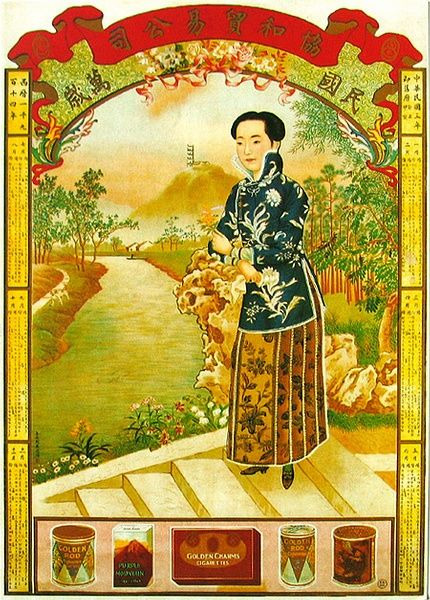
Source here
Calendar painting from 1914. This collar has a rectangular edge and is trimmed with fur.
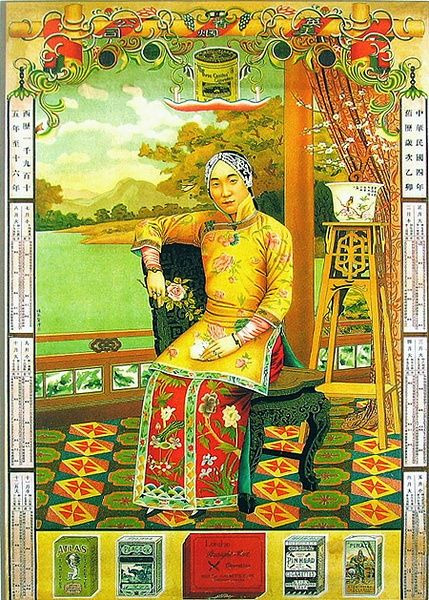
Source here
Calendar painting from 1915-1916. This collar has a rounded edge and wide binding.
However, this ultra tall collar wasn’t everybody’s cup of tea and normal height collars existed as well, especially in the beginning and end of the decade. A new invention of this era was this tall collar with slightly rounded edges closed by two to three pankou----in some extreme cases four. I believe they were stiffened, but even if they were not, the use of wide, heavyweight binding could give it shape and rigidity. This style probably grew out of collar styles 2 and 3 from 19th century Han women’s collars, but it is going to become very iconic and distinct later in the 30s so let’s label it collar style 8. All Han women’s standing collars before the 1970s were extremely fitted, i.e. they completely hug the wearer’s neck and could sometimes be restrictive to neck movement. The loose fitted collars often seen on modern mass produced cheongsam is not historically accurate.
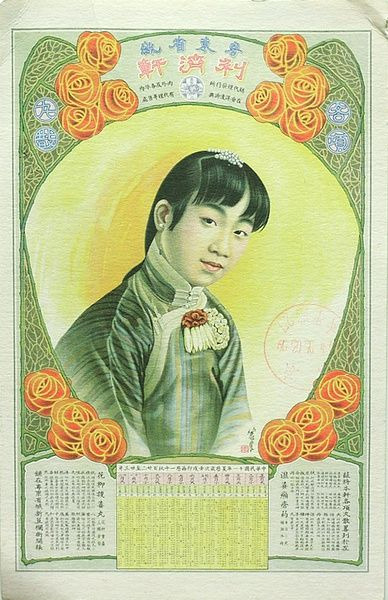
Source here
Calendar painting from 1911 showing collar style 8. It had three pankou, wide double row binding and could be closed at the front.
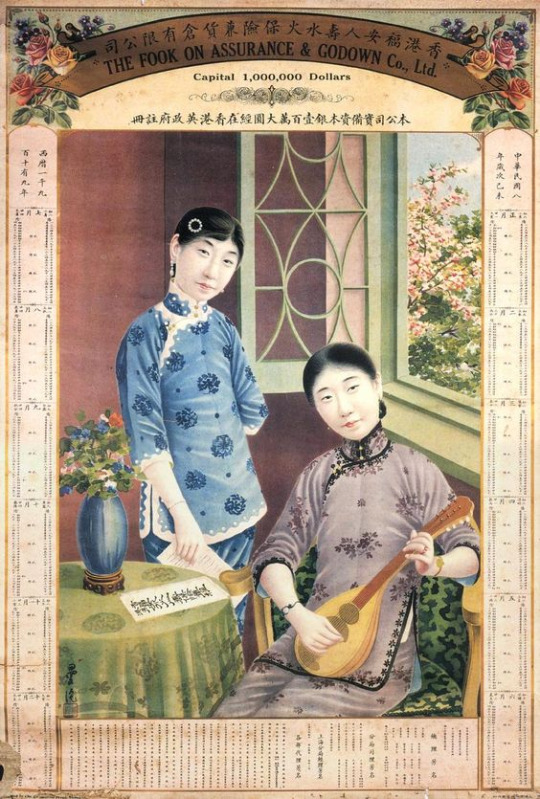
Source here
Calendar painting from 1919 also showing collar style 8. Throughout the 1890s, 1900s, 1910s and early 20s, innovative/Western trims like lace were commonly used instead of plain binding.
Quickly turning our attention to menswear. I’m not a menswear expert so feel free to add info or references. In the 1910s, menswear collars followed a similar development. After looking at more photos from the period, I figured out that in the late 1900s, men’s collars still had rectangular edges and were pretty low. This was also echoed in the formal dress code issued by the republican government in 1912. You can read more about the formal dress code in this article, it’s a great guideline for understanding ceremonial clothing in the republican era.
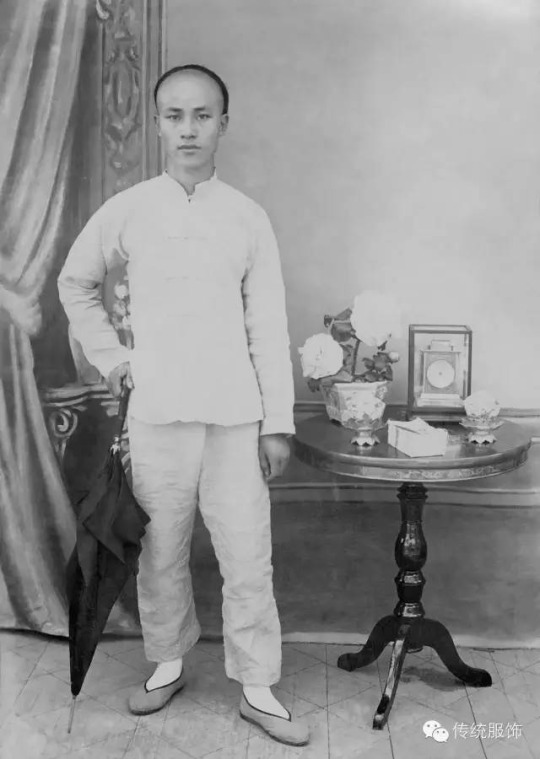
Source here (I’m probably gonna pull most of the menswear photos from the photo album in this article cause they are conveniently dated)
1907 photograph of a certain Mr Ye Jinglv, a legend who preserved his photographs from the 1900s to the 1960s, wearing a 短衫 duanshan short robe and pants.
I have no idea where this collar type came from but the three main suspects are European military uniform collars, Japanese uniform collars (also inspired by European military uniform collars) and Qing Dynasty officials’ collars (now attached to the tunic itself).
As the 1910s progressed, men’s collars gained rounded edges and grew taller just like women’s collars, but they were never so tall to the point that they could not be closed in the front. They were still closed by one plain pankou at the base (men’s pankou has always been plain). This is likely the collar style 6 I identified in part 1 but wasn’t sure about. These collars don’t appear to be stiffened, but rather just constructed of heavyweight fabric similar to the robe itself. Oh and sometimes in photographs you can see men wearing two collars, that is because both the 长衫 changshan, long robe, and 马褂 magua, riding vest, had standing collars in the 1910s, so when both are worn at the same time there will be two collars.
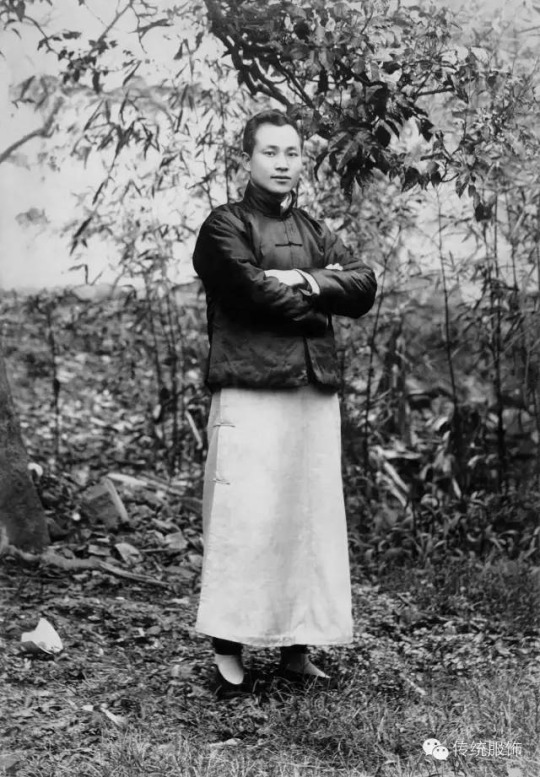
Source here
1916 photograph of Mr Ye Jinglv in a changshan and magua, collar style 6.
1920s
Summary of 1920s Han women’s fashion 1, 2, 3
Going into the 20s collar style 7 went out of fashion completely. The 20s was a wild decade and everything went, but overall collars usually ranged from medium height to tall. There is a wide variety of collar designs in the 20s, women’s dresses with no collar or Western collars like sailor collar, shawl collar or no collar at all etc. all existed, I’ll just list the most common standing collar designs of Chinese origin.
Early 20s collars decreased in height slightly but were still tall standing collars, with rectangular edges, binding and two to three pankous. Let’s call this collar style 9 because it has a will of its own. It’s weirdly reminiscent of collar style 4 from part 1 but the difference is that collar style 4 was unstiffened and had rectangular edges. I don’t think designers in the republican era ever really consciously referenced any historical collar shapes prior to the 19th century... Fashion history was a non-existent academic discipline at that time.

Source here
Calendar painting from 1920 showing collar style 9. It is unstiffened and moderately tall. It has slightly rounded edges, two pankous and a thin row of binding/piping.
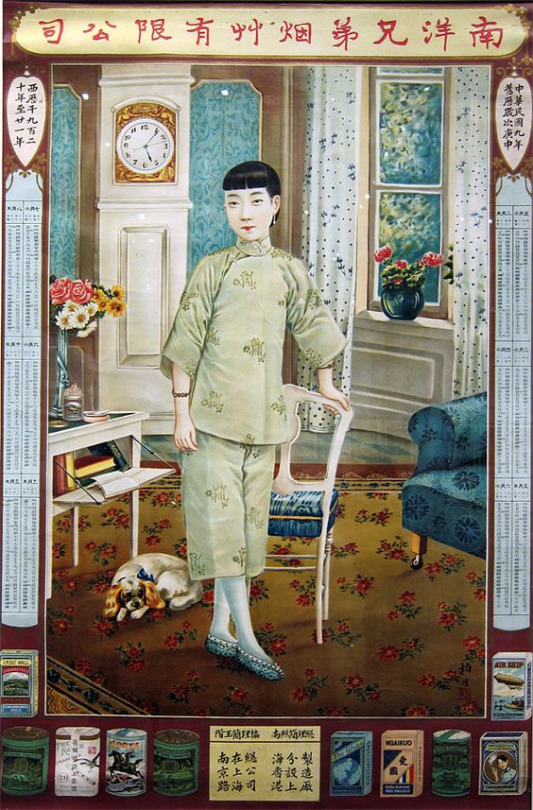
Source here
Calendar painting from 1920-21, showing similar collar style 9 with thin binding and two pankou.
Toward the mid 20s both wide and thin binding could be used and the number of pankou ranged from one to three. I’ve seen multiple times collars with only one pankou at the bottom but still could close completely at the front, which means stiffening was likely used to keep the shape of the collar; I’ll number this collar style 10. The decorations of the mid 20s pursued a tacky aesthetic and were heavily inspired by the 19th century. Alternatively, collars could be decorated with scalloped edges or geometric Western trim. The overall aesthetic was still very 19th century Chinese though. I feel like internal hooks and bars could’ve been used to close these collars, like Western or Japanese military uniform collars, but this is pure speculation.
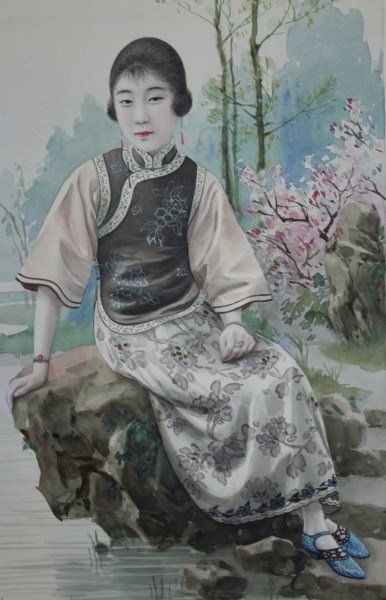
Source here
Watercolor ca. 1926 showing a medium height collar style 10. It closes with only one pankou but holds its shape very well.
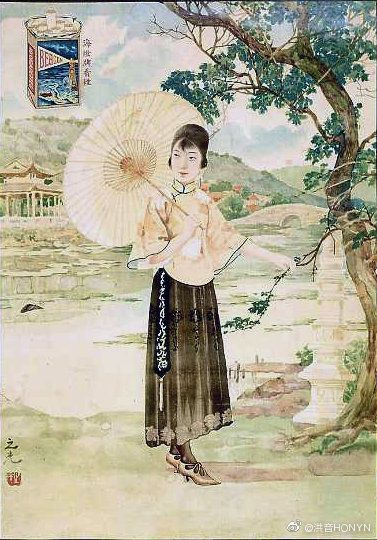
Source here or see watermark
Mid 20s artwork showing a similar collar, albeit with thin binding.
Starting from 1928-29 there was this huge trend of using tall, side closing collars. This collar was stiff and structured, tall and closed at the side or back with either pankou or hooks and eyes/bars. It covers the wearer’s neck completely and doesn’t have any openings. This kind of collar was frequently applied to the newly developed cheongsam, which was a one piece dress, to emulate a Western flapper look. The art deco aesthetic was en vogue in the years 1929-31, so there were many cheongsam with innovative closures instead of pankou. I personally really love this look it’s very underrated. This would be collar style 11; it was truly one of a kind since it was never seen again in Chinese fashion history. Rest in Power.
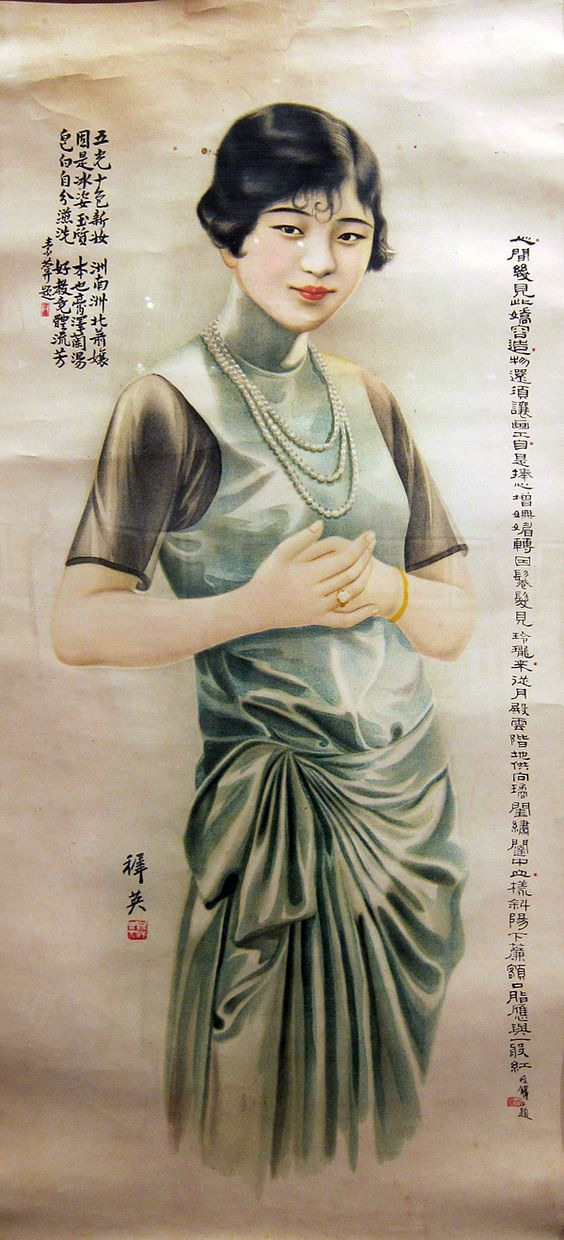
Source here
Painting ca. 1929 showing collar style 11. This is probably closed at the back? Anyway the pankou were not emphasized at this time.

Source here
Kong Sang Hong ad from 1929 showing collar style 11 without visible pankou.
Now menswear again. In the 20s, the tall collar style 6 went out of fashion, following trends in womenswear. The new collar was medium height and still closed by one pankou at the base. It could have either rounded or rectangular edges but rectangular or mostly rectangular edges seem to be more common. I’d say this is similar to collar style 10.
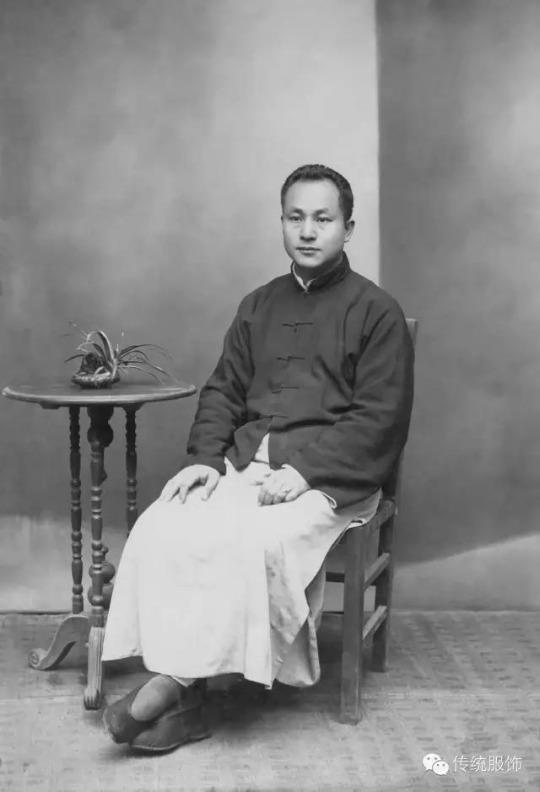
Source here
1925 photograph of Ye Jinglv wearing again changshan and magua.
1930s
Summary of 1930s Han women’s fashion 1, 2
Returning to Han women. Collar 11′s popularity continued to around 1931, when it began to be replaced by a revived version of collar style 8. Collar style 8 with three buttons dominated the majority of the 30s, and these buttons didn’t necessarily have to be pankou; any kind of decorative loop button, clasp or frog closure could be used. 30s collars emphasized the roundness of the buttons, so beads or pearls were commonly used as buttons.
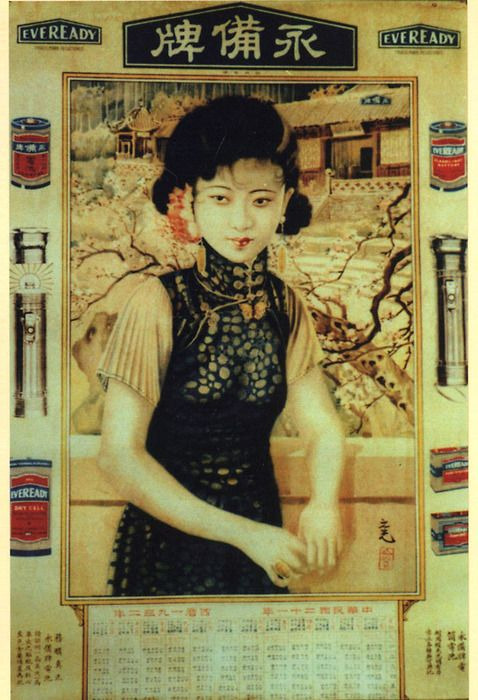
Source here
Calendar painting from 1932 showing collar style 8.
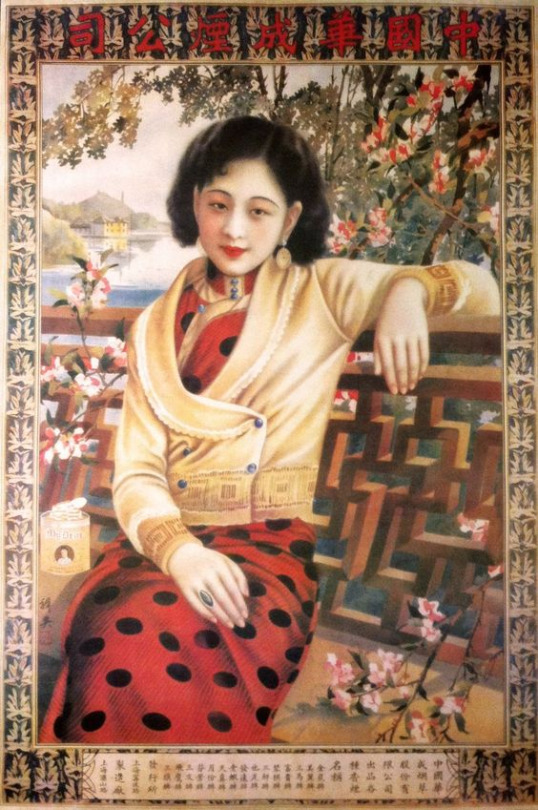
Source here
Mid 30s advertisement showing collar style 8 with bead buttons matching those on the cardigan.
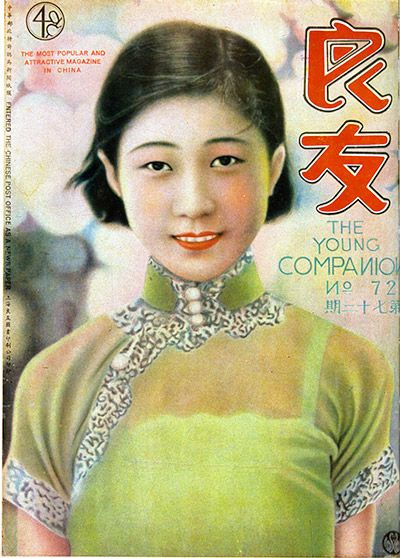
Source here
1932 cover of The Young Companion showing collar style 8 with pearl/bead buttons. Oh collars on a transparent cheongsam would usually be opaque because the interlining/stiffening needs to be hidden.
Men’s collars of the 30s decreased in height again, this time becoming really quite short. Round and rectangular edges coexisted but round edges were still more common. Still closed by one pankou. Not many changes otherwise (gosh, menswear always changes at a glacial pace, y’all men need to step up your game). This foreshadows 40s Han women’s collars so let’s label this collar style 12. Men’s changshan and magua collars stayed this way well into the 40s and 50s.
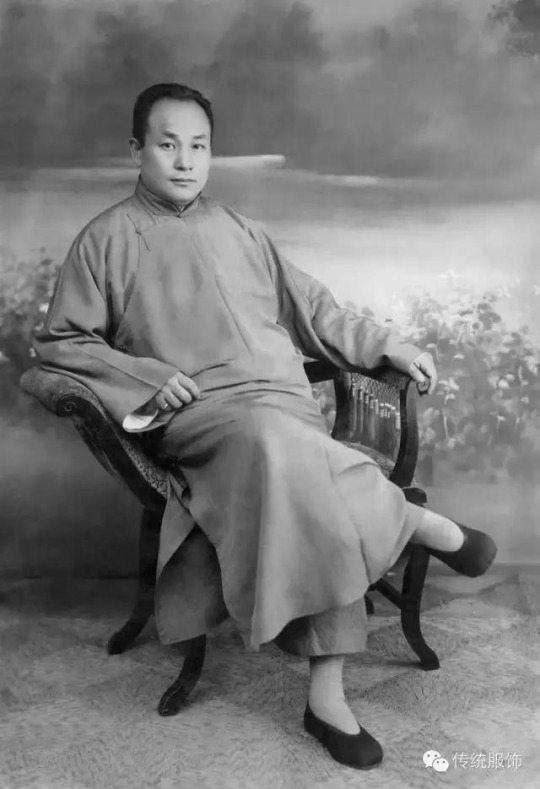
Source here
1935 photograph of Ye Jinglv in changshan with collar style 12.
In the late 30s/early 40s collars dropped in height significantly, regressing to collar styles 9 or 10. It was usually closed with one or two pankou (because there was only enough space for two maximum).
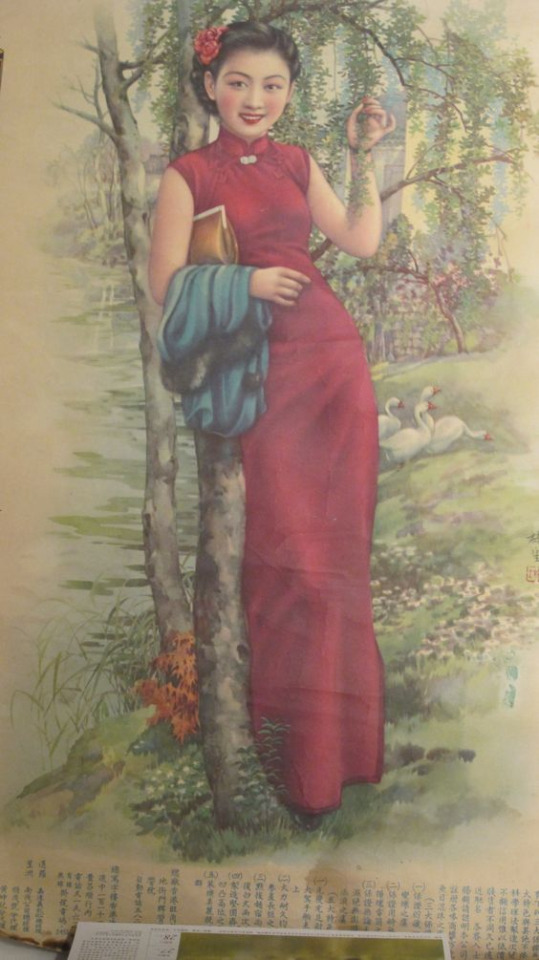
Source here
Late 30s/early 40s artwork depicting the revived collar style 10.
1940s
Summary of 1940s fashion here
As the 40s progressed collars became even shorter, eventually so short that only one pankou could be attached. This developed from collar style 9 but since it was so low and so distinct to the 40s I’d say this is also collar style 12. It may appear similar to collar style 3 from the 19th century but it has rounded edges and is also stiffened and slightly taller.
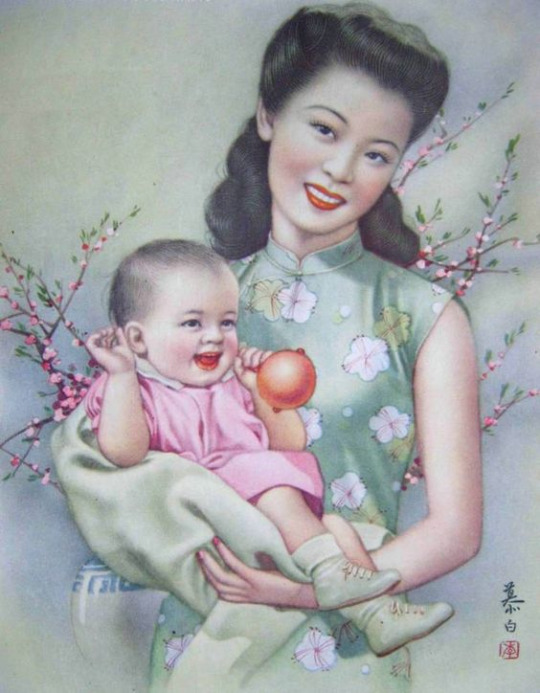
Source here
Early to mid 40s artwork showing collar style 12.
19th century trims became fashionable again in the early 40s, especially collars with multiple rows of binding/piping. However because of scarcity of materials during the war, that style was only ever seen on actresses and celebrities; cheongsam collars for the average woman were plain.
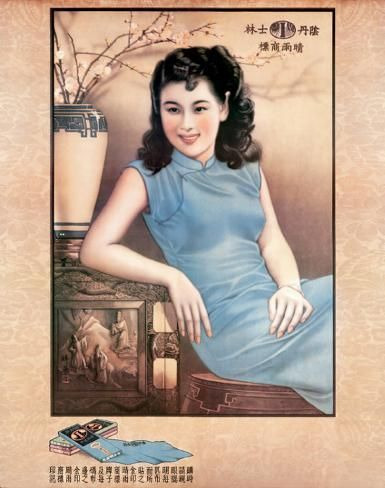
Source here
40s Indanthren fabric ad, showing low collar style 12.
In summary:
Collar style 7: cursed belle époque (ca. 1890-1918) women’s collars that touched the wearer’s face. Extremely tall, stiffened, both rounded and rectangular edges existed. Closed by one pankou at the bottom but sometimes had more pankou for ornamental purposes. Worn by Han women and the plain version for men.
Collar style 8: first appeared in the 1910s, popular in the late 10s and throughout the 30s. As tall as possible without restricting the wearer’s neck movements, stiffened, rounded edges. Closed by two to three pankou. Decorated with wide binding or Western trims like lace in the 10s, multiple rows of binding in the 30s. Worn by Han women.
Collar style 9: developed from collar style 8, popular in the early 20s and late 30s/early 40s. Slightly shorter (medium height), stiffened, rounded edges. Closed by two pankou. Thin binding. Worn by Han women.
Collar style 10: developed from collar style 9, popular in the mid 20s and late 30s/early 40s. Slightly shorter (medium to low height), stiffened, rounded edges. Closed by one pankou at the base. Both wide and thin binding. Worn by Han women and a similar version by men.
Collar style 11: distinctly Western collar, popular 1929-1931. As tall as possible without restricting the wearer’s neck movements, stiffened, rectangular edges. Closed at the side or back with pankou or hooks and eyes. Often plain or of the same fabric as the dress. Worn by Han women.
Collar style 12: developed from collar style 10, popular throughout the 40s. Very short, stiffened, rounded edges. Closed by one pankou at the base. Commonly had thin binding. Worn by Han women and men.
Phew, I thought this was gonna be a short and simple post but it ended up taking way more of my time than I wanted it to. I’m gonna do one last post on the 50s and 60s and maybe address the state of Chinese standing collars nowadays, hopefully that will be actually simple to make lol.
307 notes
·
View notes
Text
A Deep Conversation with BTS' RM on His Group's Early Years, Drake, Whether BTS Is K-Pop, and More
"I had a sense of urgency and desperation about going after my dreams," says BTS' leader
I was someone who wanted to go to a top college, an Ivy League school by American standards,” says RM, BTS’ leader. “I was a typical student who was trying hard to achieve. And then I trusted [HYBE founder] Mr. Bang, and I started to walk down a different path. And I had a sense of urgency and desperation about going after my dreams.” RM’s gifts as a rapper, songwriter, and producer have been essential to BTS’s development, as have his wide-ranging intellectual interests. In an interview from his label’s headquarters, the artist formerly known as Rap Monster discussed whether BTS should be considered K-pop, the uniqueness of South Korean hip-hop, the highlights of the Most Beautiful Moment in Life era, and more.
You quoted the great abstract artist Kim Whan-ki recently: “I’m Korean, and I can’t do anything not Korean. I can’t do anything apart from this, because I am an outsider.” You said that was a key thing you’ve been thinking about lately. How does that idea apply to your work? So much of the pop and hip-hop I listened to came from America. But for me, as a Korean, I think we have our own characteristics and some kind of localized identity. I can’t really explain it very well, but there are some characteristics that we Koreans have, or maybe Eastern people. So we try to kind of combine those two things into one, and I feel that we created a new genre. Some may call it K-pop; some may call it BTS, or some Eastern-Western combined music, but I think that’s what we’re doing. If you think about the Silk Road in the past, there’s this idea of Eastern people and Western people meeting on some kind of, like, big road and maybe doing selling and buying of stuff. I think this story repeats itself, and some kind of new, interesting phenomenon is happening. We feel very honored to be existing in the very eye of this big hurricane.
There’s so much great Korean hip-hop, including your early heroes Epik High, who are still active. What did you hear in it early on, and what do you hear in it now? There’s always a process of when something new comes into another culture, where the identity gets transformed and it changes and adapts to this new place. Obviously, there are differences between Korea and the United States that affect the music. For example, Korea is not a multiethnic country like the United States. So there are different sensitivities that are underlying the music. Korean rappers of course have their own unique and different lyricism, their own situations and hardships that they fit into the process. As a Korean, obviously, these are the things that resonate with me.Obviously, there’s a saying there’s nothing new under the sun. So especially for people like us, in the margins of the world, so to speak, we think about how can we transform this and how can we make this our own. So these are the things that I think about when I try to balance the inspiration of Korean and American rappers. And, I think, now though, there’s a convergence of all genres of music.
When BTS first started, there was this conflict in some people’s minds and in your own between the idea of being a rapper or being an idol, which we’d call a pop star. This is obviously something you’ve addressed in song. Maybe you can explain a little about that conflict and why it seemed so important at the time? When I was young, I wanted to be a writer of prose and poetry, and then I found rap. And a lot of what I wanted to do went into the music. And, yes, there was this idea of being a pure artist or a pure rapper. So in the beginning, it is true that when we were debuting as a pop act, there were times when I had to sort of reorganize my identity and then reflect on what my identity is. And at the beginning we didn’t see positive results. We didn’t have a lot of fans. We didn’t have great results. There were some times when we were mocked.
So it is true that it took some time for that identity to develop and settle itself. But, you know, whether it’s rap or pop music, or whatever it is, it is another method for me to show my mind and express my voice, and having that resonate with people. So a lot of that conflict resolved itself. And I think things today are very different from what they were like in 2013, because even though there’s still a lot of discussion about what is pure, what is authentic, what is sincere, what’s an artist, what’s a pop musician, those boundaries have become less and less meaningful. As long as I can show what I’ve written, it’s valid as the continuation of my dream and what I always wanted to do.
It feels like BTS really found itself around the time of Most Beautiful Moment of Life. That’s where everything came together. How do you look back on that time? Despite the name, Most Beautiful Moment in Life, that was actually a very tumultuous period for me and for us. There was the tough image we had in 2 Cool 4 Skool, in those early stages, a sort of exaggerated expression of toughness and that angst. And then we sort of slowed down a little bit and tried to express the emotions of young people who have really nothing more than dreams. It was a more honest sort of expression, and we witnessed how it was resonating with a lot of people.There was some confusion because this was something new, and we were showing ourselves to be more vulnerable, more delicate, which was very different. But we realized that it was meaningful, and as we went forward to the Love Yourself series, we started to discover that more and more as we continued.
I know that many fans don’t see BTS as part of K-pop. And you, yourselves, have said that “BTS is the genre.” How do you see it? That’s a very important debate. Because what they call K-pop, that genre is expanding very fast. For example, some so-called K-pop groups have only foreigners, from Europe, India, China, like, everywhere. There are no Korean members, but they do the K-pop thing, they’re switching the parts, and so on. BTS is expanding very fast as well. And K-pop is now so wide. Somebody could say that K-pop is for Koreans who sing a Korean song. That could be K-pop. But what about “Dynamite”? We sing the song in English. But we’re all Koreans, so somebody may say it’s a K-pop song. Or they may say it’s just a pop song, because it’s in English. But we don’t actually really care about whether people see us as inside or outside K-pop. The important fact is that we’re all Koreans, and we’re singing a pop song. So that’s the reason why we said that our genre is just BTS. That debate is very important for the music industry, but it doesn’t mean very much for us members.
What music really changed your idea of what’s artistically possible? I started with Nas, Eminem, the golden age of hip-hop. And the turning point was Drake, in 2009, when he released Thank You Later. That album was kind of shocking for me because it was kind of a freaky thing that a rapper actually sang. So after that a lot of rappers began to sing, deciding to put the melodies into their songs across the genres, between raps and melody. So, yeah, that was the moment.
When you rapped that your “shadow … is called hesitation,” what did you mean by that? It can be called hesitation or cautiousness, but, I think, there is a form of hesitation that prevents you from taking risks and prevents you from challenging yourself.
I know you motivated the members by saying that your grandkids might watch your Grammys performance someday. Is that something you think about often? It gives me a lot of goosebumps sometimes that our every moment leaves traces online where everyone can see them. So, yeah, I think that helps us keep motivated.
Some film actors have a saying, “Pain is temporary. Film is forever.” [Nods.] Life is short. Art is forever.
© source
49 notes
·
View notes
Text
A Brief History of Dwarfism
(TW/CW: cure, medical, pet culture and slavery mentioned, discriminative language)
LYZ LENZ Updated: June14, 2017 Origional: February 25, 2015
When researchers from the biopharmaceutical company BioMarin told representatives of the Little People of America about the results of a drug that could potentially cure one of the causes of dwarfism, they expected a better response than the silence they were treated to. This caught the BioMarin folks off guard. “I think they wanted us to be happy,” says Leah Smith, LPA's director of public relations. “But really, people like me are endangered and now, they want to make me extinct. How can I be happy?”
BioMarin isn’t the only company trying to eliminate dwarfism. For years doctors have been using limb lengthening and hormone treatments to counter and cure the over 400 underlying causes of dwarfism. And yet, despite these efforts to eliminate what many people see as a disability, society can’t stop staring. From The Lord of the Rings to Peter Dinklage in Game of Thrones, people have long been mesmerized by depictions of LPs. As Smith explains, “It doesn’t matter how normal I am, it’s hard for people to look at me an see anything besides Leah the LP.”
Dr. Judith Hall, a clinical geneticist whose work focuses on short-limbed dwarfism, explains that our staring and our desire to cure are intimately connected. “In the same way that ancient societies viewed those people with differences as a pathway to the divine,” Hall says, “I see them as a pathway to access the knowledge of nature. There is so much to be learned about humans and our genetic make-up by studying the genetics of people with short stature and anyone with a ‘disability’ although I hate that term, don’t you?”
But understanding our curiosity and desire to cure requires an understanding of the history of dwarfism, which lies in the nebulous intersection of medicine and myth.
For much of early history, LPs were considered to be intimately connected to the divine. In fact, pre-literate societies often saw all people with disabilities as conduits to heaven. The ancient Egyptians associated dwarfs with Bes, the god of home, family, and childbirth; and Ptah, the god of the Earth’s essential elements. (Both gods—representing youth and the Earth—play a role in enduring myths and stereotypes, like the fairy tales that claim that dwarfs live underground, or the stereotype about the childish nature of people with short stature.) Because of their connection with the gods, dwarfs were often revered in Egypt, and were allowed to serve high roles in the government.
Whereas dwarfs in the Old Kingdom of Egypt (2575-2134 B.C.E.) were often jewelers, linen attendants, bird catchers, and pilots of boats—all positions of high-esteem, by the Middle Kingdom dwarfs were more likely to be personal attendants or nurses. These positions, while still respected, were comparatively lower status. Historians surmise that dwarfs were relegated to these roles because their short limbs made them perfect midwives and the association with the god Bes. Of course, even in this age of reverence, dwarfs lived lives of bondage.
In ancient Rome, the attitude toward dwarfs was less reverential. Owners would intentionally malnourish their slaves so they would sell for a higher price. In ancient Greece, dwarfs were associated in a menacing and lurid way with the rituals of the Dyonisian cult; art from that period shows them as bald men with out-sized penises lusting after averaged-sized women. This same pattern of reverence and bondage also appears in China and West Africa, where LPs were so often servants of the king. A 17th-century author wrote that the Yoruba people in West Africa believed dwarfs to be “uncanny in some rather undefined way, having form similar to certain potent spirits who carry out the will of the gods.” And out of a similar reverence for their stature, the courts of China employed dwarfs as entertainers and court jesters. Here there also may have been a level of fetishism; Emperor Hsuan-Tsung kept dwarf slaves in the harem he called the Resting Palace for Desirable Monsters.
By the time of the Italian Renaissance, LPs had become a court commodity all over Western Europe, Russia, and China. There are tragic tales of court dwarfs and their wild antics. Jan Bondeson writes in The Two-Headed Boy about Nicolas Ferry, the infamous court dwarf of King Sanislas Leszynski of Poland. Ferry was given to King Sanislas when he was about five years old. The King promised his father he would be given the best education and medical care. Ferry’s father didn’t even consult his wife, who had to journey to the court to say goodbye to her son. Ferry, who may have also had learning disabilities, was spoiled and terrorized the court with his antics—kicking the shins of servants and crawling up the skirts of ladies. He even threw a dog out of the window when he believed the Queen loved the dog more than him.
Another Italian, Isabella d’Este, marchioness of Mantua, viewed dwarfs as collectable items. She hoarded them in her vast palace along with art, classical writings, gold, and silver. She also tried to breed dwarfs and kept them in a series of specially designed rooms, with low ceilings and staircases to scale. This was more for their display than comfort. One of Isabella’s dwarfs was “Crazy Catherine,” an alcoholic who stole from her mistress and whose misdeeds were laughed off as entertainment. The history of courts throughout Europe and Russia tell similar tales of dwarfs employed as jesters, or little more than pets—laughed at, loved, and never fully allowed to be human.
As the age of monarchy ended, the era of medicine and medical curiosity arose to fill its place, often providing more opportunities for LPs. Dwarfs were put on display—by others or themselves—for money. In a time where very few occupations were open to LPs, putting yourself on display in a freak show was at least a way to make a living. While traveling around provided LPs with more independence, it also opened them up to the gaping and insensitive curiosity of the public and medical professionals.
It shouldn’t come as much of a surprise, then, to say that LPs were subsequently taken advantage of by greedy brokers and agents. In his book Freak Show, Robert Bogdan explains the phenomena of human exhibits, singling out the insular nature of communities as a leading cause. Animals and humans that were outside of the norm were exciting curiosities; different races, ethnicities, and disabilities were all billed as novel entertainment. Bogdan quotes a handbill advertising a Carolina dwarf in 1738 who was “taken in a wood in Guinea; tis a female about four foot high, in every part like a human excepting her head which nearly resembles an ape.”
FOR MOST OF EARLY HISTORY, THE RESPONSE OF DOCTORS TO LPS WAS TO MEASURE EVERYTHING—NOSE, HAIR, GENITALS. THIS MEANINGLESS COLLECTION OF DATA IS OFTEN ACCOMPANIED BY CONDESCENDING NOTES ON THE APPEARANCE AND INTELLECT OF THE DWARF.
From these human exhibits came the growth of dime museums, midget villages, and Lilliputian touring communities, where many LPs rose to prominence. But while these exhibitions took center stage, several LPs made incredible, albeit quieter, contributions to history. There were people like Antoine Godeau, a poet and bishop best known for his works of criticism, or economist Ferdinando Galiani, one of the leading figures in the Enlightenment. Then there’s Alexander Pope, a classical poet known as the “most accomplished verse satirist in English.” Plus Benjamin Lay, an early abolitionist and good friend of Benjamin Franklin. And Novelist Paul Leicester Ford, artist Henry de Toulous Lautrec, electrical engineer Charles Proteus Steinmetz. The list goes on.
Yet even in this time, as many LPs grew to prominence, medicine was able to do little more than collect data. Dr. Josef Mengele, the infamous Nazi doctor, kept an LP family of Romanian performers captive in Auschwitz, subjecting them to various tests and experiments that included pulling out teeth and hair specimens. Mengele is remembered as the angel of death—a cruel doctor who performed unscientific and often deadly experiments—yet his data collection on LPs isn’t much different than that of the medical community in centuries prior.
For most of early history, the response of doctors to LPs was to measure everything—nose, hair, genitals. This meaningless collection of data is often accompanied by condescending notes on the appearance and intellect of the dwarf. Even as late as 1983, Mercer’s Orthopaedic Surgery offered this observation about achondroplasia: “Because of their deformed bodies they have strong feelings of inferiority and are emotionally immature and are often vain, boastful, excitable, fond of drink and sometimes lascivious.”
The obsessive data collection reads like a stack of clues, wherein doctors hope to find an answer to the riddle of difference. With nothing else to do, like the Egyptian pharaohs and the courts of kings, doctors found themselves staring too.
In the absence of a cure, most early doctors focused on prevention. They believed that dwarfism was caused by the mother having seen another dwarf or animal. In fact, for most of medical history many disabilities and unexplained deformities were chalked up to maternal impressions. Consequently, pregnant women often sequestered themselves away from their communities, acting like they themselves had a disability.
This isn’t different from the modern approach to “curing” dwarfism. With early genetic testing, many in the LP community are worried about unborn dwarfs being allowed to be born.
In the aftermath of World War II, LPs found more and more opportunities to work outside of entertainment. This was due in part to Billy Barty, a film actor and television star who, in 1957, organized a meeting of LPs in Reno, Nevada. This meeting eventually led to the founding of the Little People of America, a powerful non-profit that advocates for the rights of LPs in America.
THE HISTORY OF DWARFS IS A HISTORY OF SUBVERSION, STEREOTYPES, EXPECTATION, AND SURVIVAL. IT’S THE HISTORY OF HOW PEOPLE TREAT OTHER PEOPLE WHO ARE DIFFERENT.
Before Barty, with the exception of circuses and traveling groups, most LPs were isolated. There was no way to band together to advocate for civil rights. A little more than 30 years after that first meeting in Reno, the Americans with Disabilities Act was passed in the United States, granting LPs more access and freedom than ever before.
The history of dwarfs is a history of subversion, stereotypes, expectation, and survival. It’s the history of how people treat other people who are different. And, while much has changed, very little is different. The tension between curiosity and cure is still prevalent. The popularity of shows like Little People, Big World and The Little Couple, while laudable for their portrayal of normal people with difference, show that we can’t stop looking at LPs. And companies like BioMarin and non-profits like Growing Stronger, which all seek to find a cure, show that we can’t stop trying to change them.
Yet, as a geneticist, Hall dismisses the notion that she is trying to change the LP community. She describes her work as merely offering a choice to individuals. “There are genetic tests for Downs Syndrome, but they haven’t eradicated people with Downs,” Hall says. “In the same way, the work I do and the work of other scientists isn’t to eradicate difference, but rather to offer options for dealing with it. It’s all about offering choices, really.”
But Smith, the LPA's director of public relations, pushes back. “The world is full of difference.” Smith says, “Sometimes I wish people would look elsewhere.”
BY LYZ LENZ
Origional Article Post: https://psmag.com/social-justice/a-brief-history-of-dwarfism-and-the-little-people-of-america
71 notes
·
View notes
Note
What was dating/courtship/(arranged) marriage/whatever like back in the Taisho period?
Aww yeah, Taisho Roman, Anon! A period in which GIRL CULTURE was going into full swing! There were new fashions, magazines, cafes, short haircuts, manicures, girls were being recognized as consumers and had major cultural impact in this period, and they were starting to get more and more opinionated about love and romance and having a dreamy match!
But, a lot of those classic Taisho (1912-1926) fashions didn’t start to develop until a bit later in the brief (and generally nostalgically looked at in rose colored glasses) period sandwiched between the more forceful social upheavals of the Meiji (1868-1912) and Showa eras (1926-1989). Kimetsu no Yaiba takes place at the beginning of the Taisho Period, when Japan is already a full generation or two into Westernization, so a lot of the 'newness' has worn off in the cities. Meiji mindsets still would have a lot of influence on marriage, and what it meant to be a girl in the first place (we must talk about girls especially, because they had a lot more riding on marriage).
However, the Taisho period was also interesting as an in-between period, when the arm of the law did not reach all that deep into the mountains. Despite all the Meiji reforms on to everything from religion to marriage registration to compulsory education to how to count your own age, many of these were not uniformly enforced until later in Showa. The deep countryside of Taisho, far from the rapidly developing cities and social farming villages, was still a place where demons and secret societies of swordsmen could thrive. Meanwhile, clinging to old ways by using loose definitions under modernized laws left old demon hideouts like Yoshiwara much like they were in Edo times. Which is to say, having a mix of both old and somewhat ungoverned Japan, and new, fashionable Japan, as well as the classic divide between rich and poor, gives us a couple of very different worlds of marriage. This going to be a history lesson, and then we’ll use that to interpret what this might mean for the Kimetsu no Yaiba characters, at least as much as my heart feels so inclined.
The reason I focus on girls in this answer is because their marriage determined the fate of their life, especially due to laws like the Meiji Civil Code of 1898 and the associated family system, which almost always had a male figurehead. Despite, and perhaps because of the rapid embrace of modernity, there was a return to Confucian values which placed women at a very low status in society and made them almost entirely reliant on men (I also touched on this in a post about Uzui having three wives in this period, but concluded that their ninja society was counter-cultural in the first place). These reforms were considered a step back from the relative freedoms and independence Edo women could have, for example, it wasn’t until these reforms that women were required to take their husband’s name (except in cases of a son-in-law marrying into her family as an adopted heir, in which cases it typically never would had been an oldest son). While Taisho is remembered for the new freedoms and free thinking it encouraged in young women, it also had a strong “good wife, wise mother” push for what women should strive for. The Meiji government was also concerned about population decline and labor shortage, which is why they encouraged larger families.
Speaking of the labor shortage, that brings us first to a discussion of poor girls. It was very common for girls from poorer families to go work far from home as soon as they graduated elementary school (technically required, but graduation rates could be pretty low anyway). It was not a matter of selling them to decrease the burden on the family, as in Kanao’s case, nor a matter of selling them into prostitution. They were still a member of their own families with parents anxious about their welfare, and the girls usually did domestic labor or factory work or childcare, things like that. Kiyo, Sumi, and Naho seem a bit young for this, but girls only a bit older would had been working just as hard.
The girls who labored for economic reasons very often delayed marriage until they were better off. For them, getting married at 25 would had felt relatively early; being over 30 at the age of first marriage wasn’t at all unusual. In very poor peoples’ cases, marriage registration was not very strictly enforced either, so sometimes that can mess with historical research, but we do know it could vary a lot. Furthermore, some regions had very, very different standards of what ages were normal for a girl to get married, but put very simply, the national averages in the Taisho period at the age of first marriage were 27 for men, and 23 for women (yes, we’ll get to those rich girls later in this post). As marriage would determine a lot of her future stability, she’d of course had been getting as stable a catch as she could, and since the times of samurai-era fussy class rules were over, she could marry up if she was attractive enough. Since these were often girls who worked for the sake of caring for their own parents and siblings, it was likely they’d have family agreements involved before settling down with someone, and it would be felicitous for everyone. At least according to Meiji laws, the head of her family would be the one granting permission for the union anyway, so if you didn’t have grandpa’s approval you were kind of screwed if you wanted to do things neatly. Since marriage was not really her decision, cases of being called home because the family had arranged someone for her wouldn’t be surprising.
In the context of Kimetsu no Yaiba, perhaps Nezuko, who already helped a lot with the family finances both with her sewing labor and her abacus skills, would had left the family to go work in town if their father was stronger and her presence wasn’t so needed around the house. I also find it likely that Aoi might had been laboring away from home when her family was killed, meaning she had never seen a demon until facing them at the Final Selection.
Alright, now for the people who might had actually had some fun with courtship… the rich girls. The prim and proper young ladies, the “reijou,” as they were called. Kanae and Shinobu were total reijou, Mitsuri was a total reijou, Satoko (Swamp Demon victim) and Tokie (almost Swamp Demon victim) were all total reijou. The latter two, being 16-year-olds with offers of marriage, were well on their way to securing their futures, sort of like landing the perfect corporate career right out of college. They would, after all, be financially dependent on their husbands. And men of that class were indeed looking for happy domestic lives, as we see in how three men wanted Tokie’s hand because she was so renown for her cooking, but more so in the fact that Kazumi and Satoko actually had the chance to court each other and grow affection for one another.
This was a big Taisho step forward in the culture of “omiai,” arranged marriages between families. Nowadays people may still turn to omiai if they’re awkward about dating or somehow or another haven’t managed to make a love match on their own, or they’re done fooling around and want to settle down with someone who will be family to them instead of an exciting romance. In Taisho, since pretty much every marriage was an arrangement between families with the head of the family’s approval, “arranged marriage” was less a matter of “long-since promised to one another by our families” and more just… “marriage.” However, what makes this a step forward is that there was now a culture of actually meeting each other in advance and having some say in if they actually liked each other.
Maybe a couple would meet on their own (we’ll get to that) and had chemistry and therefore got permission from their families to court each other; or, if they were introduced by outside parties who assumed they’d make a good match, or matched via a matchmaker with photos and formal meetings (we’re getting to poor Mitsuri-chan!), then they might get that one chance to make an impression and decision. In those cases it wouldn’t necessarily be easy to turn someone down given all the pressure to make it work out, but unlike in Edo times when perfect strangers (especially of high society) would be married off to each other with no say, Taisho youth had the chance to put their foot down and stop it.
So, where would a single man in possession of a good fortune and in want of a wife go looking for someone to court instead of seeing who he winds up with at an omiai? Why, to the bride store—I mean, the secondary school for girls, of course!
It’s not leery at all, all those girls were there for the sake of scoping out a match anyway. Only about 15% of 12~17-year-old girls went on to secondary school after elementary school in the first place, and if you hadn’t quit to get married part way through (legal marriage age for girls in Meiji was 15, then 16 in Taisho, but for reijou 17~19 was pretty normal) or didn’t have a marriage lined up for right after you were out, the general idea was that you were doing something wrong. In fact, simply graduating for the sake of having finished an education, and even more shocking, going off to—gasp!!—university to continue one’s studies for the sake of, goodness gracious, knowledge which would be totally useless to a good wife, wise mother??—was so, so outside the norm that 18-year-old women who might had chosen this (*coughShinobucough*) were judged very, very harshly. Women who had the means and could and did go on through graduate school, but by and large, no one wanted that for their daughter. Quitting school to get married was the better sign of success. It was also a common insult to refer to girls who weren’t as attractive as having “a face for graduation.” Ouch!
Now, before we go on, it’s worth mentioning that no one really had a problem with reijou graduating and delaying marriage so they could go off to polishing school to learn arts like flower arranging and music (and Kanae could totally do these things before the Kocho parents were killed. And I just now got totally sidetracked rereading the part of the light novels when little Shinobu brags to Himejima how Kanae could do anything from flower arranging to playing the koto to making tea and how all the boys in their neighborhood had crushes on her). Buuuut, if the reason a reijou wasn’t married by the time she graduated secondary school was because of her looks, there was no guarantee she’d find a husband even if she did pour effort into bridal skills.
Which brings us to Mitsuri-chan. Poor, poor Mitsuri-chan.
Our girl grew up in a happening shopping district of Tokyo with all the latest fashions and entertainments, lots of date spots* where courting couples were finding love and happiness and the emerging girly consumer culture feeding her similar idealized content that magazines and social media do today. Not only did she really, really want someone to feel a special connection with, to have a place in which she feels she belongs, but she would had grown up feeling that her self-worth was tied to her worth as a bride. Being a good bride was a way of being a good daughter, and she loved her parents too much to want to be the young lady who failed to find a fitting husband. They went the omiai course, a way to try to ensure a good match and her forever happiness and security, and instead she got that rejection. It wasn’t just that Mitsuri was chasing a doki-doki shoujo manga feel, but she was an outright failure of her station in life.
(*I admit I had no idea what these dates would look like, maybe I should check out “Haikara-san ga Tooru” one of these days.)
Since Mitsuri’s parents seemed most concerned about her happiness, even recognizing the emotional needs she had met in her dangerous, not officially recognized society of people who carried very illegal swords. Therefore, if Iguro did ask them for permission to court and marry her, they’d probably be very willing to grant it. Besides, this guy is a Pillar, he can totally financially support her (and the fact that Mitsuri could financially support herself and her own appetite probably made her feel better about herself too, for it took some of the dire marriage pressure off). If Mitsuri wasn’t bothered by his facial scars, they probably wouldn’t be either (at least in the context of already having wrapped their brains around the fact that their daughter is likely to die a violent death). At least, I interpret them this way, as she never expresses any guilt about having run away without permission to join the Corp. She’s very much a Good Daughter™ and would probably want them to approve of her marriage, too.
As for orphans in the Corp, they probably would marry whoever they want, should the right match come around. I’ve wondered before if Wisteria House daughters make popular girlfriends, for the families there can appreciate the situations the swordsmen are in. If they are orphans with conservative tastes who still feel they need the formality of seeking permission for marriage, they’d probably look to their own cultivator to approve in place of a deceased head of a decimated family. Even Tecchikawahara felt the need, as an adoptive parent, to see Haganezuka securely married off, and in the light novels set up an omiai so that he might enjoy some domestic bliss (which didn’t work out because she was a stupid choice of a match for a Nichirin swordsmith). Speaking of the light novels, there’s also a side story of the Kamaboko boys getting invited to attend a local wedding while recovering at the first Wisteria House introduced, and Tanjiro thinking about Nezuko’s future bridal prospects and just wanting her to be happy. (Dang, the light novels actually touch on marriage a lot.)
But hey, Tanjiro… you’re an Eldest Son™. Even if your little brothers hadn’t been killed off, you’d be the one with the pressure to carry on the family. Taisho Common Knowledge says you gotta get a wife, dude. Knowing that, Tanjiro probably always assumed he’d meet the right dog-like-lily-of-the-valley someday, and finding a way to make her happy despite their poverty was always a given in some way or another. She’d probably have been a poor girl in the first place.
But, Tanjiro in a post-canon world, deciding he wants to take Kanao as a wife? Well, he’s his own head of the Kamado family, but he’d probably seek Urokodaki’s blessing, for he’s the closest thing to a parental figure in Tanjiro’s life. He probably formally stated his intentions at Shinobu’s altar and asked her blessings too. But Kanao, being a working woman and co-master of the Butterfly Mansion, and having grown up outside of traditional family structures, probably is fine deciding this matter on her own (especially since working her way up to making her own decisions is significant).
In the InoAoi case, Inosuke probably never bothered asking anybody anything. Aoi, having no parents around, probably just went with it and they were informal, or she forced formality upon him in some way, I could see either course happening.
In the case of ZenNezu, they ain’t going anywhere without Tanjiro’s formal approval. Not that this will be hard, of course. Uzui might jump in and say no just to mess with Zenitsu.
Pillars might had at least formally informed Oyakata-sama of their intentions to wed. Who knows what Ruka’s family background is, probably people who were familiar with the demon slaying gig and who recognized what a responsibility it was to marry into the Rengoku family. As for Pillars marrying each other in potentially child-producing unions, Oyakata-sama’s permission was probably an absolute must. There may be pressure either not to get married at all because their work is too important, or to retire to prioritize their health. Whether they continue working as colleagues or not, their position as Pillars outweighs any social Taisho norm about good wives and wise mothers and providing husbands and heads of families.
As for marriage registration, the Corp manages to exist without the meddling of the law (woot woot Taisho in-between period), so it’s pretty likely Corp members would not bother with this formality.
Speaking of norms in late Meiji, Hashibira Kotoha and Shinazugawa Shizu would not only have had little say in their marriages, but also little recourse for leaving them. They would have had no way to return to their families and expect to be supported, and under the late Meiji era family system, the children belonged to their fathers. Even if they did secure a divorce (not terribly uncommon in late Edo/early Meiji, actually), they’d have had no way to make sure their children were safe...
So anyway! Back to happy canon marriages! Kamado Tanjuro and Kie likely would not have had formal wedding portraits, but I can see Tanjiro and Nezuko making sure to get them. Maybe Tanjiro would not have considered it a necessity if he were just a normal humble charcoal farmer, but after all they’ve been through and since they have the means, I feel it would mean a lot to them, especially with all the new people who would probably be present at their weddings and would probably want those keepsakes too.
358 notes
·
View notes
Text
Interview #492: Edra Galzeran

q: Give a short introduction of yourself: a: My name is Edra Galzeran, I am a photographer from Terrassa, a small town near Barcelona. In my teenage years this industrial city had little appeal for an awakened mind; it was just a place to run away from. So It was then that I started my escapades to Barcelona, a place where things happened. I left the calmness of my town, to plunge into the excitement, the madness of the city. At some point Barcelona also began to feel smaller and so began a long journey of ten years during which I had the opportunity to live in ever larger cities such as Berlin, Moscow and Kiev with the exception of Venice.
In the meantime, I studied Translation and Interpreting and began to take photographs and paint. All these cities fascinated me and still do, probably because they are places where the West meets the East. It’s funny how now, some years later, I have changed the excitement by the silence since I now live in a small town. In a way, I have returned to my origins. Now I love the closeness to nature, the Waldeisamkeit, being alone and wonderful in the forest.
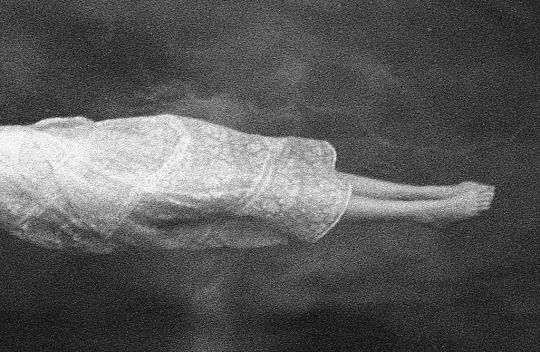
q: How has the past year been for you? a: This terrible year was undoubtedly a turning point for me in many ways. On the one hand, the calm caused by the confinement, the slowing down of work, gave me the opportunity to become a de facto photographer, to show my work to the world. I have always photographed, but I could say that the germination of my capacity as a photographer is in Ukraine because there I started to really “see”. I bought my first SRL camera and started to walk and photograph what was around me, what caught my attention even If I did not think about becoming a photographer at that time. Things would start later, a few years after I returned to Barcelona in 2008. I had a lot of material that I had collected over the years, I did a workshop on analog photography and at that time I started to imagine the idea of becoming a photographer. I certainly already was, but it’s always difficult to say it out loud, when you are self-taught. Later it was difficult to find time to make a website, etc, because of my work, because of time constraints. However during the confinement I had to stay at home and had a lot of time to work on my new career.
On the other hand, this year has shown the fragility of human beings and our way of life has changed completely. The Covid has equaled us all more or less in disgrace. I personally was not affected by the disease, nor was anyone around me, although I had to face a family tragedy that kept me on my toes for almost three months.

q: What is your series "Immram" about? a: The word “Immram” is an old Irish word that usually means "journey". At the same time it is the name of a kind of story from Irish literature. These stories are about the sea voyage of a hero to the Otherworld. They were mostly written in the Christian era (8th century), but still preserve elements of Irish mythology.
Immrams focus on the exploits of heroes in their search for the Otherworld, which in these cases is located on the westernmost islands of Ireland. The hero sets out on his journey to experience adventure or fulfill his destiny and usually stops at other fantastic islands before reaching his destination.
My project Immram is a journey into the Otherworld, to my own Otherworld, it is a journey between past and present, between truth and fiction, between paganism and Christianity. It is my winter journey to an old, hostile island in the west of Ireland, where all kinds of beliefs are permeable. It is the smallness of man in the face of a nature steeped in fatalism.
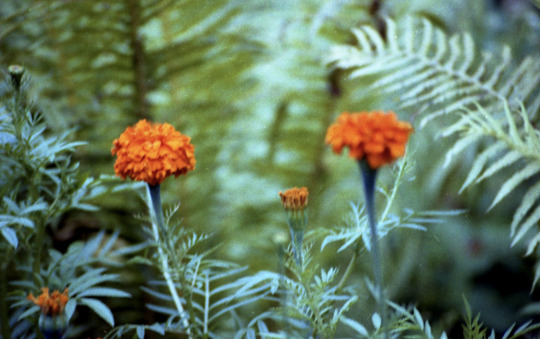
q: In your series “Flor de marge”, you revisited photos you took more than a decade ago in Ukraine. What was the process like for you and what did you rediscover? Do you feel you photograph differently now? a: It was all part of the same process of creating myself as a photographer. During this slow period of confinement, I began to look at the material I had produced over the years, but it also brought to mind all the forgotten photos that I had taken in Ukraine. It was a surprise to discover that I was already a photographer back then. I found some interesting pictures. When I looked at them, it was like seeing the person I was ten years ago. It was very revealing. I saw the gaze I had then; I saw a harsh reality that unfortunately is shaping our days more and more, at least in Spain.
As for photography, things are quite different today. Paradoxically at a time when everyone shamelessly exposes their private lives in the social media, no one wants to be photographed in the street. I do not think that is so terrible. I remember a time when I lived in the middle of Barcelona, in the Gothic quarter, near the Plaça Real, and dozens and dozens of tourists were loitering around. I often heard the click of the camera, and probably I will be seen in many pictures with my always loving red scarf.
Today I photograph differently; I have shifted the street photography of my beginnings in favour of introspective photography. People are becoming more and more inaccessible, at least in Western countries and it is difficult to capture these special moments. When you have to ask for permission, all the magic of the moment disappears. But there is one wonderful exception, I am thinking now of Katty Grannan, a photographer who does great portraits of people on the street who want to be photographed. My new projects are more oriented towards nature, maybe because I now live two minutes away from the forest. They are more introspective, the human presence has become more residual.

q: You mentioned that you are also a painter. Do you see a link between your photography and painting? a: Perhaps in the dominance of strong contrasts and in a certain tendency, especially in more recent works, towards pessimism, in line with the times, although I am a rather cheerful person in my everyday life. In any case, I believe that I am in a phase of experimentation in both photography and painting.
q: Upcoming projects or ideas? a: I have several projects in mind, but the most advanced is "Cal y silencio" (Lime and silence). This project deals with the phenomenon of depopulation of rural areas in Spain. The centre of Spain is a vast plateau that covers most of the national territory, a place with extreme temperatures both in winter and in summer, where only the 15% of the population live in the 53 % of the territory. In recent decades there has been a migration to the major cities of the periphery and to the capital, Madrid. The rural world in Spain is a forgotten world full of dying villages, solitude, isolation, lime and silence.

q: Any music to recommend? a: That is a pretty difficult question, because I listen to very different music from all times, from different styles and from many, many countries. Depending on my mood, I listen to music from Schubert's Winterrreise to Ravi Shankar, from The Doors to Bon Iver, from Chavela Vargas to Mina…I have long Spotify playlists that I like to play randomly. I also enjoy the discoveries of this platform, the last one yesterday, a Turkish version of the Russian song “Podmoskovnie Vechera” (Moscow nights) by Tülay German.

her website and Instagram.
Get more updates on our Facebook page and Instagram.
57 notes
·
View notes
Video
youtube
This week on Passionate Reply: We all know “Don’t You Want Me,” but the early Human League is a totally different beast, featuring a different line-up, and songs about killer clowns and wanting to be a skyscraper, on their debut LP, 1979′s Reproduction. Transcript below the break!
Welcome to Passionate Reply, and welcome to Great Albums. In this installment, we’ll be investigating one of the most surprising debut LPs around: The Human League’s Reproduction, first released in 1979.
Pretty much anyone with a general understanding of Western pop will already know the name of the Human League, and associate them, rightfully, with their early 80s hits like “Don’t You Want Me.” For many, the Human League were the first genuine synth-pop that they had ever heard, and their work in the 1980s has been immeasurably influential in bringing the notion of electronic pop into the mainstream. But before they were hitmakers and game-changers, the Human League were a very different band.
Music: “Being Boiled”
“Being Boiled” was the first thing the Human League would ever press to wax, way back in 1978. In most respects, this track is everything that “Don’t You Want Me” is not: its pace is languid, its structure is shapeless and meandering, and rather than a simple and relatable love story, its lyrics offer us a strange and opaque condemnation of the tortures endured by silkworms during textile production. While fascinating, and endearing in its own morbid way, “Being Boiled” does not exactly scream “hit record.” The Human League were not only a different band in a stylistic sense, but also with respect to their personnel, driven by a creative core comprised of budding synthesists Martyn Ware and Ian Craig Marsh. Prior to the release of the breakthrough album Dare, Marsh and Ware would abandon the group over creative differences, and go on to form Heaven 17 instead. It was vocalist Phil Oakey, and producer Martin Rushent, who would create the sound that their name is now so strongly associated with, and this early incarnation of the group is probably best thought of as an entirely different entity. This album, Reproduction, was their first full-length release, and is perhaps the best introduction to their pioneering sound.
Music: “Circus of Death”
“Circus of Death” had appeared as the B-side to “Being Boiled,” and was included once more as the second track on *Reproduction.* It has a lot in common with the other track it accompanied: a plodding pace, a dark and obtuse lyrical theme, and a sparse, fully electronic instrumentation. The Human League were among the first British groups to utilize a totally electronic sound, devoid of any traditional instruments besides the voice, though in this underground and more experimental context, it doesn’t present a threat to the status quo of pop the way that Dare would a few years later. Alongside fellow proto-industrial acts associated with "the Sound of Sheffield," like Clock DVA and Cabaret Voltaire, they dwelt on the fringes of good taste, crafting subversive music for subversive people. “Circus of Death” introduces us to a demonic figure called “the Clown,” who controls, and torments, human beings by use of a drug called “Dominion,” in a scenario that sounds a bit like Huxley’s Brave New World. It’s worth remembering that while younger generations are quick to think of clowns as icons of evil and terror, clowns were unironically beloved as bringers of joy for most of the 20th Century, and these early portrayals of clowns as killers were indeed shocking at the time. Preceding “Circus of Death,” and opening the album, is “Almost Medieval,” a track with some similar themes, but a rather different composition.
Music: “Almost Medieval”
While “Circus of Death” is slow and dirgelike, “Almost Medieval” showcases the more aggressive side of *Reproduction.* It opens the album with a starkly simplistic tick-tocking beat, reminiscent of an unaccompanied metronome, before bursting into its punk-like sonic assault--a musical representation of how seemingly predictable and deterministic machines can also create something outrageous and unexpected. The lyrics of this track seem pointed towards the past, with the narrator exclaiming that they “feel so old,” and as if they’ve died many times before. Juxtaposed against the thoroughly modern setting of an airport with tarmacs and jet engines, it might be taken as an expression of the horror a person from the past might feel if they were shown the world of the future, created by capitalism and high technology. While it isn’t very accurate, we have a tendency to think of the “Medieval” world as a barbaric, unclean, and uncivilized era, full of witch hunts, chastity belts, and the deliberate erasure of “ancient wisdom.” “Almost Medieval” turns that idea on its head, suggesting that perhaps our world is the one that’s truly barbaric. The image of its narrator, “falling through a rotting ladder,” can be taken as a rejection of the notion of a “ladder” of progress. Similar themes of open-ended symbolism, and the sorrow of modernity, can be found on “Empire State Human.”
Music: “Empire State Human”
Like “Almost Medieval,” “Empire State Human” is lively and faster-paced, with driving percussion. With its straightforward rhymes and repetitive structure, it readily encourages the listener to sing along, almost as if joining in some sort of ritual chant. It’s an idea that Marsh and Ware would return to in their Heaven 17 days, with tracks like “We Don’t Need This Fascist Groove Thang.” “Empire State Human” was the album’s only single, and thanks to this exposure, and its (relative) palatability compared to the rest of their catalogue, it remains one of the best known tracks from the early Human League. “Empire State Human” makes its concept pretty clear, with less ambiguous lyrics and an easy to follow mix that brings Oakey’s voice to the fore: the narrator wishes to become a building, and a mighty skyscraper no less, which might rival the achievements of the Pyramids of the ancient Egyptians. While it is clear that that’s what the song’s about, what we do with this once again high-concept subject matter is up to us. I like to think that this is some kind of perverse commentary on the unnatural and alienating experience of urban living, which may come with the feeling that the concrete and rebar structures that surround us are more significant to our lives than the people who may live or work in them. City life is addressed more directly by the track “Blind Youth.”
Music: “Blind Youth”
“Blind Youth” is probably the most “grounded” track on the album, in terms of its theme, making pointed remarks about “dehumanization” and “high-rise living.” It’s tempting to think of it as a sort of parallel to “Empire State Human,” with a broadly similar musical backdrop, and a more literal expression of the theme hinted at more obliquely by “Empire State Human.” With its focus on the experiences of the titular “youth,” “Blind Youth” can also be contrasted with “Almost Medieval,” whose narrator keens about feeling old. Where “Almost Medieval” deals with the disgust an older person feels at the decrepit state of the human race, “Blind Youth” shows the demented, unthinking joy of the youth, who have grown up in an industrialized and urbanized world, and don’t know different--or better.
While there have been many classic underground albums whose covers aimed to shock and displease polite society, the cover of Reproduction is one of the few that I feel would still be seen as offensive, over 40 years later. It was allegedly the product of a miscommunication between the group and the illustrator commissioned to create it; the band requested a scene in which people are dancing above a ward of babies in glass-topped incubators, and the striking angle, which seems to show people crushing infants underfoot, is an unintentional aspect of the design. Unintentional or not, this crudely violent aspect dominates the final composition, and lends it vileness and immediacy. Like the lyrics of many of the songs, the combination of the cover and title can be interpreted a number of ways. Perhaps it’s a glib commentary on human reproduction as fun and games: we partake in the “dance” of courtship and sexuality, and babies drop beneath our feet. Or perhaps it suggests a contrast between life’s enjoyments, like dancing, and its stressors, like the responsibilities of parenthood. It’s hard not to see so many crying, seemingly distressed infants without becoming upset oneself, and I think the deep instinctual revulsion that this piece inspires is part of why it’s remained so resonant in its subversiveness.
As I mentioned in my introduction, the Human League have gone down in history chiefly for the music they made later, which has largely buried this early period as part of their legacy--at least in the public eye and outside of the dedicated diggings of motivated enthusiasts. If you’re a fan of what you’ve heard from this album, you’ll probably enjoy their 1980 follow-up Travelogue, as well as their EP, Holiday ‘80. Given the emphasis on long-form albums among music aficionados, EPs and their exclusive tracks are quite frequently missed, but Holiday ‘80 is a gem from this short-lived line-up, featuring the fragile “Marianne” as well as a cover of the stadium favourite “Rock ‘N’ Roll,” made famous by Gary Glitter. Thumbing its nose at everything the culture of “rock and roll” stands for, and transposing this hymn to its greatness into an abrasive and sterile lunar landscape of synths, this is one of my favourite covers of all time, and seems to prefigure how a very different Human League would later become the archnemesis of all that rock fans held holy. It was also one of very few tracks to be performed on Top of the Pops, and subsequently see not a rise, but a drop in the singles charts!
Music: “Rock ‘N’ Roll”
My favourite track on Reproduction is one that appears on its second side, unlike the other tracks I’ve talked about so far: “Austerity / Girl One.” Side Two of Reproduction is mainly focused on longer and more narrative-driven tracks, and this is no exception. Like the opener of the second side, “Austerity / Girl One” is a medley, albeit one of two pieces that are original compositions and not covers, as medleys usually are. This track’s story is both timeless and modern, a bit like a contemporary King Lear: the “Austerity” half deals with an aging father, incapable of understanding his children, dying alone and ignored, while the “Girl One” half puts us in the mindset of his daughter, a New Woman whose life is hectic, but also bleak. It’s a story that many of us will relate to, about people who try their best with what they’ve got, but still feel as though they’ve failed in life. Its simple, but effective musical backdrop of wan synth pulses allows the narrative, and Oakey’s evocative portrayal of it, to take center stage. That’s everything for today, thanks for listening.
Music: “Austerity / Girl One”
12 notes
·
View notes
Note
I plan to read Desiderata but I don't know a thing about Rammstein. What should I know before diving in?
That depends very heavily on what about Rammstein would interest you.
I’ll be honest, anon, Desiderata is not the best story to start with if you’re completely new to R+. The story assumes a familiarity with the band’s history, as well as 1980s East German politics, and depicts both with terms and viewpoints familiar at the time. It’s not very accessible if you want to read a story about Rammstein, I’m afraid, it is very much a period piece.
That said, I can talk a little about what made me write Desiderata; if you’re interested in any of those topics, you’re probably good to go. I will also add some pointers as to how to begin a journey into Rammstein in general. This will be a very long post beneath the cut.
-------------
1) I’m interested in life during the GDR. I’m especially interested in how ordinary East Germans lived, down to what they ate, the kinds of people they’d meet, where they could travel to for the holidays. What people take for everyday occurrences are anything but outside of their homes. Most of Desiderata takes place in the pre- and early-Rammstein era (1985-1995), when the band members didn’t know they were going to get so big, nor what would happen after the reunification of Germany. I wanted to depict their era realistically. Desiderata is a written painting of that time.
2) I wanted to write on the anti-authoritarian character. To distill a long and complex history down, Rammstein has their origins in Ostpunk, and many of its band members spent their early life resisting the government in one way or another. They didn’t all do this in the same way, nor always with the conscious desire to stick it to the government. Sometimes they paid for it anyway. In Richard’s case, with terrible consequences, as his arrest and detainment by the Stasi finally made him flee the country. Desiderata is written in Richard’s POV and includes a sequence on what might have occurred during this time, as well as an analysis of his general psyche on the years leading up to that arrest. Desiderata’s account relies heavily on actual interviews Richard has done, as well as published Rammstein material, so if you’re interested in a character study of this sort you might like it.
3) I did not want to depict the above through the patronizing lens commonly found in Western media. It’s easy to fall into the trap of binary opposites when you’re writing about stuff like this: Richard was oppressed by the GDR so he must hate everything about the GDR, and/or furthermore, the GDR must have been evil. It’s the other way around if you’re approaching this from an anti-capitalist lens: if the East Germans had known the ‘freedom’ which lay beyond the wall was actually mid-stage capitalism, and if they’d known how badly that shit would break down in a couple of decades, they wouldn’t have wanted it.
Now I do not know what the objectively correct political position is here. But when you’re writing a character study of Richard, it shouldn’t be either of those. It’s definitely not how Rammstein looks at their past, judging by the interviews they’ve given and the books they’ve published; not even Richard has such a black-and-white approach to the life he led. It’s easy to forget that when you’re writing a fic, or even an article which tries to lean on the ‘facts’; one’s subconscious biases inform how they process facts, and I want to do better than that. I’ve fallen into that morality trap before because I didn’t know any better, and as a result I wrote some really bad stories, and I am ashamed of that. Rammstein have led a rich and complicated life with ups and downs. Many of them sincerely loved the GDR, the ones who didn’t still saw plenty of self-admitted good in it. If you would like to bask in my efforts at honesty, as fragmented as it is (for in the end, I am not from the GDR), Desiderata is the best I’ve done to this date.
4) Some good old Tillchard. Yes, I admit it, Desiderata is also a pairing exercise. ‘Tillchard’ is the shorthand for the pairing between Till (vocal) and Richard (lead guitarist); they are longtime friends in real life, and they share a trust between them seldom paralleled by anyone else in the band, imo. They’ve lived together for a time, they raised their daughters together, they began their foray into music in general while being aware of each other. They have duets together for God’s sake. I’ve been digging Tillchard for ten years so I need to stop before this becomes a longer essay than it should be, but long story short, if this becomes the first pairing you’re interested in I’d recommend adding Desiderata to the fanfic pile.
Ultimately, all the above points would still work out for the best if you knew more about Rammstein. Now for the practical recommendations. See if you like their music first: currently they have seven albums out, the most recent of which is Rammstein (2019). I don’t know how hard you like your music, but in order of most hardness to least my rank goes:
Liebe ist für alle da / Reise, Reise
Rammstein (2019)
Sehnsucht
Mutter
Herzeleid
Rosenrot
My personal ranking is:
Mutter
Liebe ist für alle da / Rammstein (2019)
Sehnsucht
Reise, Reise
Herzeleid
Rosenrot
Their best tracks usually have music videos attached to them. Check them out too. R+ take serious care with their music video narratives, they’re often their own little story in themselves. Their live performances are worth watching, even in video. If you can read German, I would also recommend checking out Rammstein literature, of which there are plenty. Till has three volumes of poetry out (Messer, In Stillen Nachten, 100 Gedichte); Flake has two autobiographies (Der Tastenficker and Heute hat die Welt Geburtstag, the latter of which is available in English); Mix Mir Einen Drink is the biography of Feeling B, which many members of Rammstein played in before Rammstein, and is an invaluable source for GDR life.
Out of everything I’ve listed, as of Feb 2021, Flake’s autobiography is hands-down the best place to begin your Rammstein journey. There will be a more extensive book about Rammstein by Olaf Heine soon, but it won’t be released until later this year.
There is no end goal to how much you should be interested in Rammstein, or what about the band you ought to like. At any point in this journey, try out a fic or two, see what you like. The fandom has written about basically every music video, every notable event that happened to the band (some may include sources!), and just about every combination of pairings possible among the six. You are in very well-covered territory, I promise :D
Feel free to ask more questions if need be. There is so much you can write about this band, I’ve definitely not covered everything. If at any point in this process you read Desiderata, and you end up enjoying it, that’s all I could ask for.
20 notes
·
View notes
Text
The History behind the Fiction (aka doing tons of research for my don’t starve fancomic)
Howdy to all my friends and readers!!!! I’m real glad y'all are enjoying my Western AU! Ive got a lot of stories planned for this world and I hope yall will stick around for em all!
I don’t know if you can tell....but I love the old west. It’s one of my special interests since i was a little kid!!! Naturally, since I love the old west- I like to go out of my way to learn as much as I can about it!
Lord there’s a lot to learn though- Sorry if this post doesn't cover all my research- but if y'all have any questions please feel free to ask!! (Its gonna be a long infodump post- so be warned!)
First off Id like to talk about the characters and the setting!
I decided to set the story in the early to mid 1870s in Texas, in the fictional town of Constant. Also known as the Gilded age, post Civil War America was a period of rapid economic growth, expansion and innovation. It was also a time when many of the Old west’s most famous legends were active, and making a name for themselves! Think Red Cloud, Wild Bill Hickok, Wyatt Earp, Calamity Jane, etc.
Anyways, theres a lot of good material to draw inspiration from in this era, so thats what I did!!
Wilson is a newly graduated doctor- which i found fitting for him due to his love of science and scientific advancements.
(here is my first sketch of him!!! and his outfit!!!)
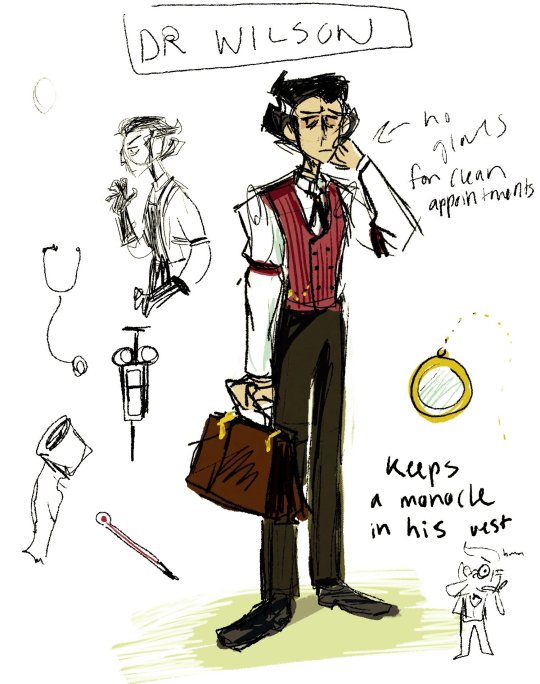
Ready made clothing was common in this era, and since wilson is relatively short- he wears elastic sleeve garters to keep his sleeves the appropriate length!
I havent shown many of his tools in the comic yet- but I frequently reference this catalogue of medical equipment to inform the procedures!
I have a book of the history of costume that let me get a good sense of the different styles of dress between working class men and upper class men in the era, but I also frequently referenced this 1873 publication of the west-end gazette
Here are the images that I partially designed Wilson and Maxwells Costumes from

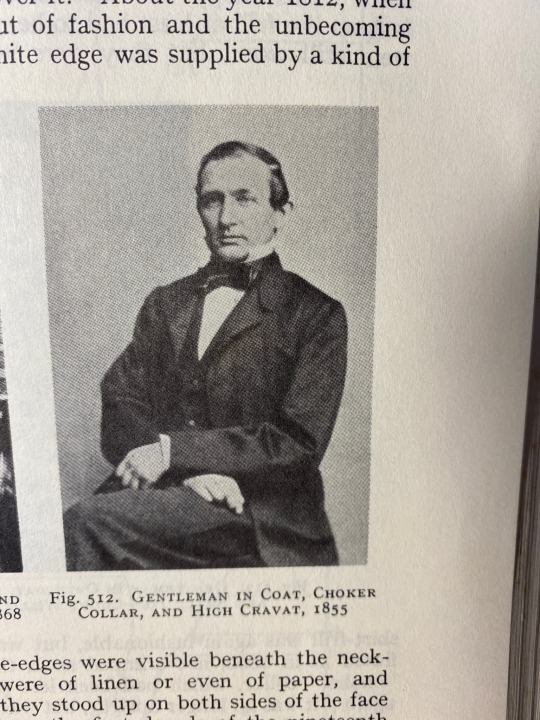
Maxwell is a wealthy Rancher with lots of land , living just outside of the town of Constant. Beef was in VERY high demand, and Maxwell makes his fortune by managing Longhorns.
Max went through a couple of iterations where I tried to incorporate his victorian skin hairstyle, but I found that it didn’t fit the era very well, based on hairstyles seen in photographs during the era. Plus, I feel that the heat of the southern united states would probably not fare well with poor old max.
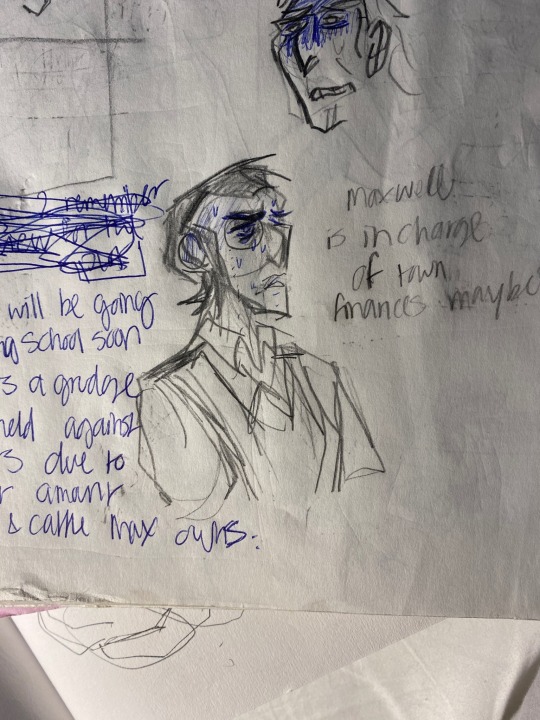
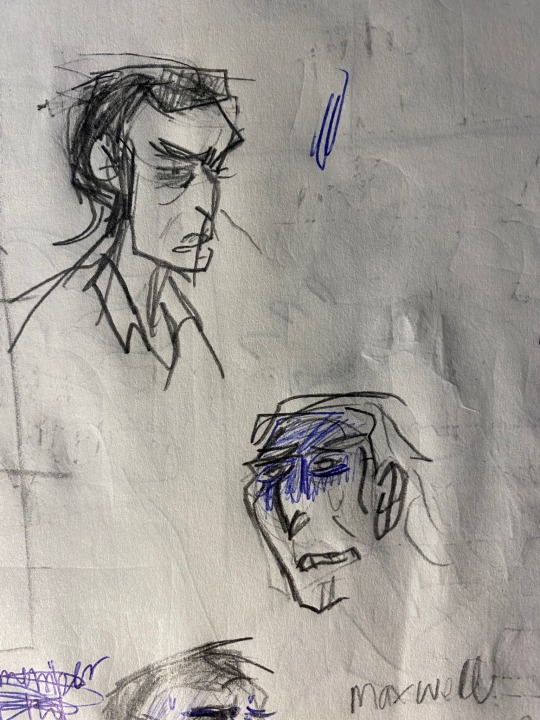
His brother Jack lives in San Fransisco- and has made his fortunes through his shipping company- which primarily exports goods from California to New York City. He lives in a comfortable home with his wife and children- but ever since Abigail died, Wendy has been acting strangely.
Wendy is one of my favorite characters to draw and write for, as well as one of the most fun characters to research for!!! She is in mourning, for her dear departed sister Abigail. her bonnet is based on those found in the M’me Demorest of winter 1860. (no reason to have a new bonnet when your old one will suffice)
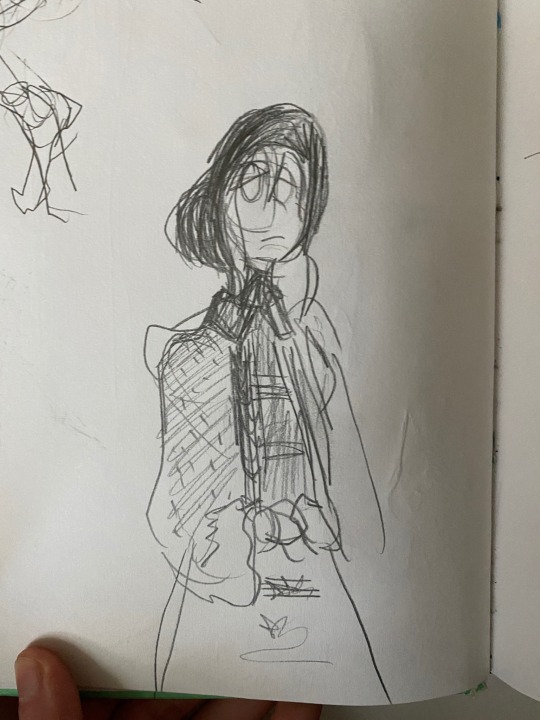
I dress her plainly in the comic, and a bit behind the fashions of the times due to her associations with her family’s wealth and image, and the demise of Abigail. Her dress is shaped after those from the late 1860s-1870s.
(I have lots of resources for women’s fashions during this era and way more- but I have found the delineator , M’me. Demorest’s Mirror of Fashions, and Godey’s Lady’s book to be some of the best resources for fashion and cultural references of the times!!!)
Usually mourning for a sibling is worn for 6 months, but Wendy definitely feels that her grief is enough to wear mourning forever.
Before she was in mourning though- she and Abigail would sport the latest in young ladies fashions! Here they are sporting an Alice style hair ribbon, and a lovely dress found in the met’s fashion plate collection as well as a lovely American casket

Aside from fashion, I try my best to keep the set dressing accurate! and it’s not just about props, but about the actual architecture that the characters inhabit.
The Carter ranch house is based on the floor plans that can be found in Hobbs’s Architecture - (jump to page 196 to see the house i modeled the residence after specifically)

The carriage too- can be found here in Brewster & Baldwin’s illustrated Catalogue !


The interior of Mr. Carter’s Home is decorated in Gothic Revival style- as can be seen in the details on the banister, as well as the ornament found in the furniture in his study. Some elements, such as his easy chair, are based on regency furniture. I find it would be too unrealistic for a crotchety old man in the American west to be entirely on top of the latest interior decorations, and besides- why throw out a perfectly good chair?
I designed his carpet myself based on english needlepoint rugs made during the gothic revival era, and as with Maxwell’s tea cups and the wallpaper in the hallway, decorated it with patterns based on the evil flowers of don’t starve.
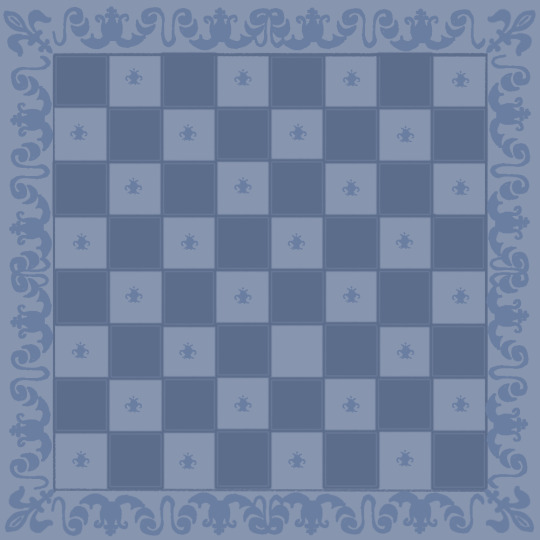
The sconces, doorknobs curtains are also based on productions from the era, though I confess that I have lost a few of my sources. (I’ll try my best to find them though!!)
If anyone is interested in looking through my sources, here is my archive.org collection! I hope yall find this stuff as compelling as I do!!
Thank yall again for reading!!! I love u!!!
26 notes
·
View notes